|
|
Post by codystarbuck on Sept 11, 2021 18:34:45 GMT -5
I wouldn't say Aussie or British humor doesn't translate here; rather, there is little outlet for either, beyond specialty channels and theaters. Hollywood so dominates and controls everything that there is little room for anything else, much like the comic book market. Marvel and DC have controlled it for decades, which has made it practically impossible for independents to survive, in the long term, with a few notable exceptions, like Dark Horse (and, to a lesser extent, Fantagraphics). PBS has been the main outlet for British humor and more independently-minded cable outlets for Australian stuff. When we got cable, back in 1982, my parents specifically refused to pay for HBO, but Cinemax got accidentally left active, for about a year and they were showing a wider range of films than HBO, including stuff from Bruce Beresford and Peter Weir, as well as Mad Max (which had been a minor drive-in type film, here, originally). The Australian tourism ads, with Paul Hogan, did a lot to create an interest in Australia; but, most of what got promoted in the entertainment world was Paul Hogan or similar material, rather than a wider thing. Canada, because of the British connection, seemed to get more of the same stuff that the UK would get, from film and tv. I doubt most in the US even knows that Neighbors is an Australian soap opera, let alone seen an episode. I only know of it from references in British tv shows. That is mostly due to our local PBS station being a strong buyer of British programming, since I was very young, which gave me a steady diet and led to seeking it out. Cinemax, similarly, got me interested in some of the Australian directors. Adam Hills is probably the best Australian ambassador going right now, but, that's a UK audience, with a minor US cult following, thanks to Youtube. When I said that the humour doesn't translate, I was specifically thinking about American attempts to remake successful British comedies seemingly without understanding what made the original funny. There were two separate attempts to translate Fawlty Towers for an American market. One starred Bea Arthur and the other John Laroquette, so they weren't short of comic talent, but they tried to make the protagonist sympathetic, missing that it is the fact that Basil Fawlty is a terrible person who brings disaster down on his own head that makes the show funny. (As a side note, I've observed that American entertainment, and comedy in particular, has an aversion to unsympathetic protagonists, although this seems to be changing in the last few years.)
And there was an American version of Red Dwarf that thankfully never made it past pilot where they made the Cat female, thereby missing the fact that (especially in the early seasons) much of the humour stems from the small, all-male cast being trapped together: like a share house from hell.
The best American adaptations of British take the basic concept and turn it into something unique that works for the local audience: like Samford & Son (based on the British Steptoe & Son) or the US version of The Office.
Oh, well, yeah, British and Aussie humor doesn't translate to Hollywood, because they think they know better, strip the project to its basic premise, then throw in the same cliched jokes and situations as every other sitcom. The American Red Dwarf had a male Cat; Hinton Battle, in the first pilot. It was the second pilot where they cast Terry Farrell as a female Cat. Jane Leeves was cast as Holly, in both versions. Rob Grant and Doug Naylor were involved in that reshoot, including casting, but didn't have full control. The original pilot script and producer was Linwood Boomer, who had a history, as a writer, on Night Court, as well as an actor, on Little House on the Prairie. He did create and produce Malcolm in the Middle, showing that he could create a funny series; but, he originated that. I don't think sci-fi was his cup of tea. One of the differences with the Office is that Gervais & Merchant were involved a bit with the development and Greg Daniels respected what they had done and credits them with giving advice that was helpful, for Michael Scott. they were the ones that said he is a good salesman, to justify why he was in the position he was, despite his incompetence. Gervais has said he wished he had established that with David Brent, earlier, though that was center to the holiday reunion special they did, where you see David, post-leaving, and you can see his sales acumen. The problems of the adaptations of Fawlty Towers, aside from the writers not being as good as Cleese and Connie Booth, was that they were too afraid to have the central character be that unlikeable. They can't grasp the catharsis of seeing someone in a position like that going off on the guests, for the petty whinings, or overreact to a situation and make it worse. A similar problem was had in trying to develop an American version of Ab-Fab, which was being done, in the late 90s. Carrie Fisher was involved, but the first hamstring was that all drug comedy had to be excised. Then, they tried to soften Patsy and Edina to the point that there was no good reason to try to redo the show, when the original was doing gangbuster business on Comedy central and they knew they wouldn't last 6 weeks. They finally gave up on the idea. The one show I've watched, from the UK, that I thought could be done in the US and done well, was New Tricks. You could find similar character types in American policing and do similar mysteries and have the mix of humor, drama and action. the police and legal system are a bit different, but not different enough that it couldn't be tweaked and maintain the same sensibility. Alas, it was not to be, which is just as well (especially in light of the botched American Life on Mars). For Life on Mars, they needed to look more to American 1970s tv cops (as LOM did, with The Sweeney) and draw from things like Columbo and Starsky & Hutch, Beretta, Serpico and such. They just saw 70s clothes and music, stuck Harvey Keitel in it and thought it would sell. There were good actors, but it was too self-consciously trying to sell the look of the 70s, instead of immersing the characters in it (That 70s Show did a far better job of that). It was also clear that they had decided, early on, that the mystery of whether Sam was dead, in a coma hallucinating or actually time traveled and their stories pointed to that one conclusion, rather than have you switching assumptions back and forth. Also, the locales they used looked too modern for 1970s New York, which was pretty run down, in large areas. Also, the city looked too West Coast (in the pilot, which was done in LA). I hated the conclusion, with a passion, as it wasn't earned and ended up being a bad Twilight Zone pastiche. |
|
|
|
Post by codystarbuck on Sept 11, 2021 20:51:34 GMT -5
Okay, moving on from Australia and back to Vietnam.... Jon Sable #13 Think Mike is telegraphing the climax? If so, this is going to be a short comic book series! Indicia Gag: Same as last issue. So there! (That's a joke; it is the same text as last issue, including the tag, "So There!") Creative Team: Mike Grell-story & art, Ken Bruzenak-letters, Janice Cohen-colors, Mike Gold-editor Synopsis: Jon Sable, after learning of the schism between mentor Sonny Pratt and his daughter-in-law and grandkids, over the disappearance of his son, Bill, during the Vietnam War, has recruited a former Green Beret pal and an ex-ARVN colonel (probably from the LLDB, Vietnamese Special Forces) to sneak across the border into Quang Tri Province, in the Peoples Republic of Vietnam, to try to find definitive proof of American POWs, in the area where Bill Pratt and co-pilot Rusty Olsen went down. 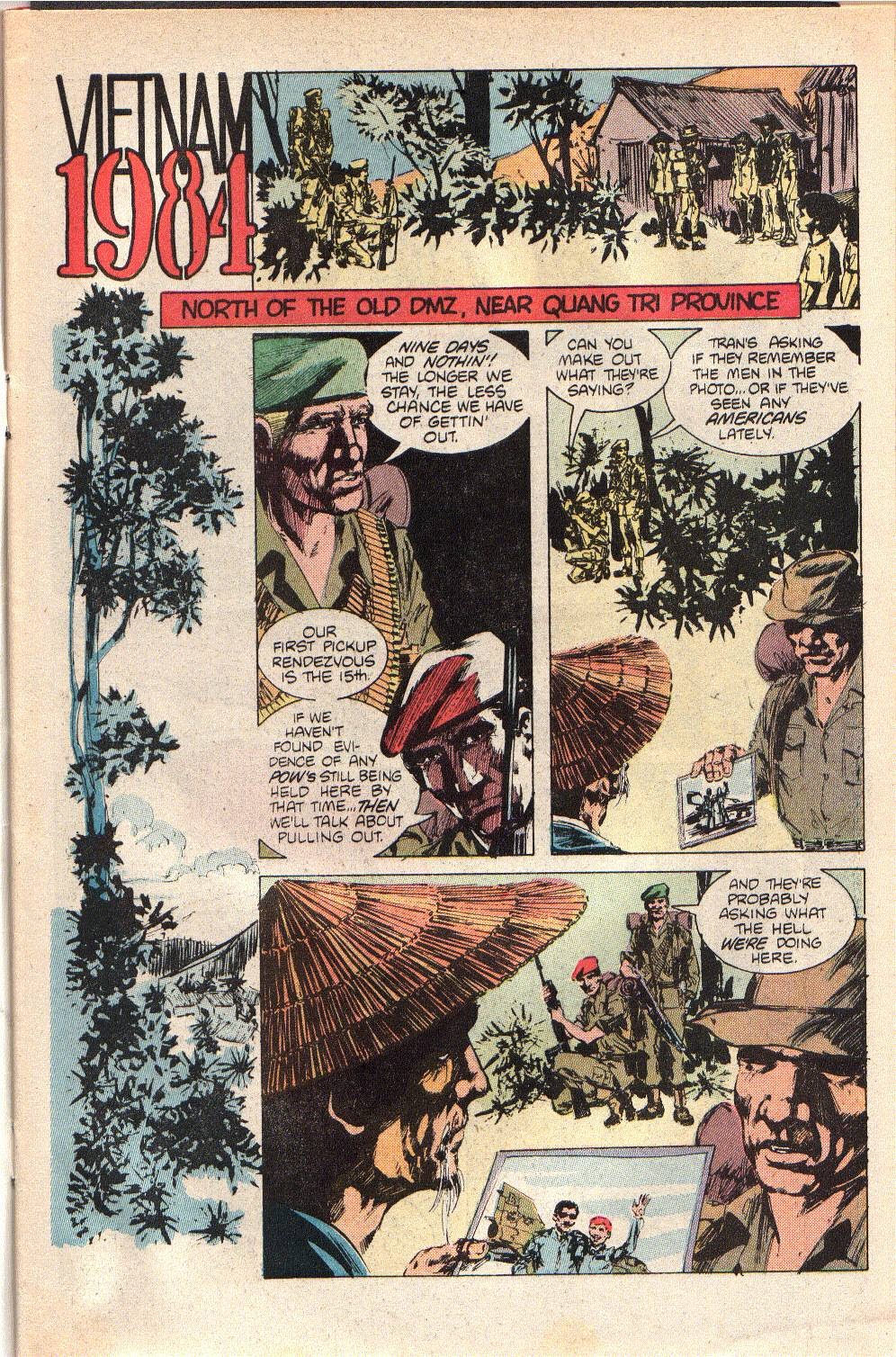 They have no luck and move on, before trouble arrives. They have been at it 9 days and their first extraction rendezvous date is the 15th. They will decide then whether to abort or not. They move on, then rest a bit. Jon is staring out at the jungle, finding himself thinking of Africa. jerry notices and asks what he is thinking about and he tells him of Africa, and a similar war. Jerry says Jon has changed. Jon replies, "Not much," and that he was scared when he first came to Vietnam and he is scared now. Jerry tells his own history, joining the Army out of high school, Airborne and Special Forces. he couldn't wait to get in it. He still can't. he asks Jon if that makes sense. Jon replies he has watched a cape buffalo from 20 feet, knowing that if it charged, he had one shot to kill it, if he hit it in the right spot and hoping that the animal would charge. Jery laughs and says they have more in common than he thought, but, "Buffaloes don't scream, do they?" Jerry talks of his wife Sheila, how she tried to draw out his demons, but he couldn't open up to her. How could she understand? her father won the Silver Star, in WW2 and said it was a different war. Jerry says war is war, but how you treat the soldiers is different. Sheila's father got a parade. Jerry notices Jon seems shaky and he says he is feeling a bit run down. Jerry tells him to get some sack time, while he takes first watch. He then asks Jon if he ever learned what the war was about. Later, when they move on, Jerry checks on Jon and he admits to being feverish. Jerry asks if he has been drinking the water from the swamps and Jon says he knows better than that, but is interrupted... 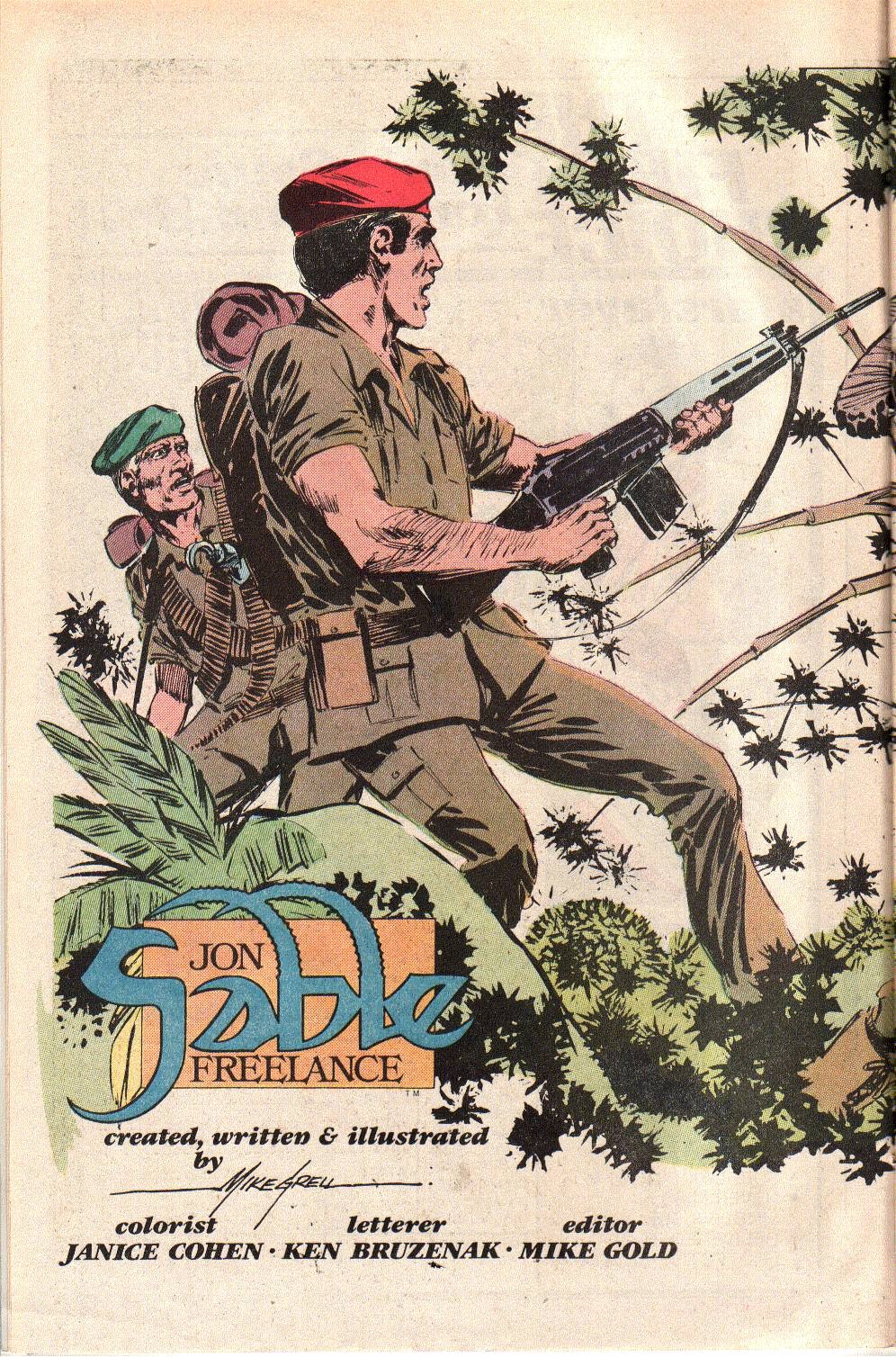 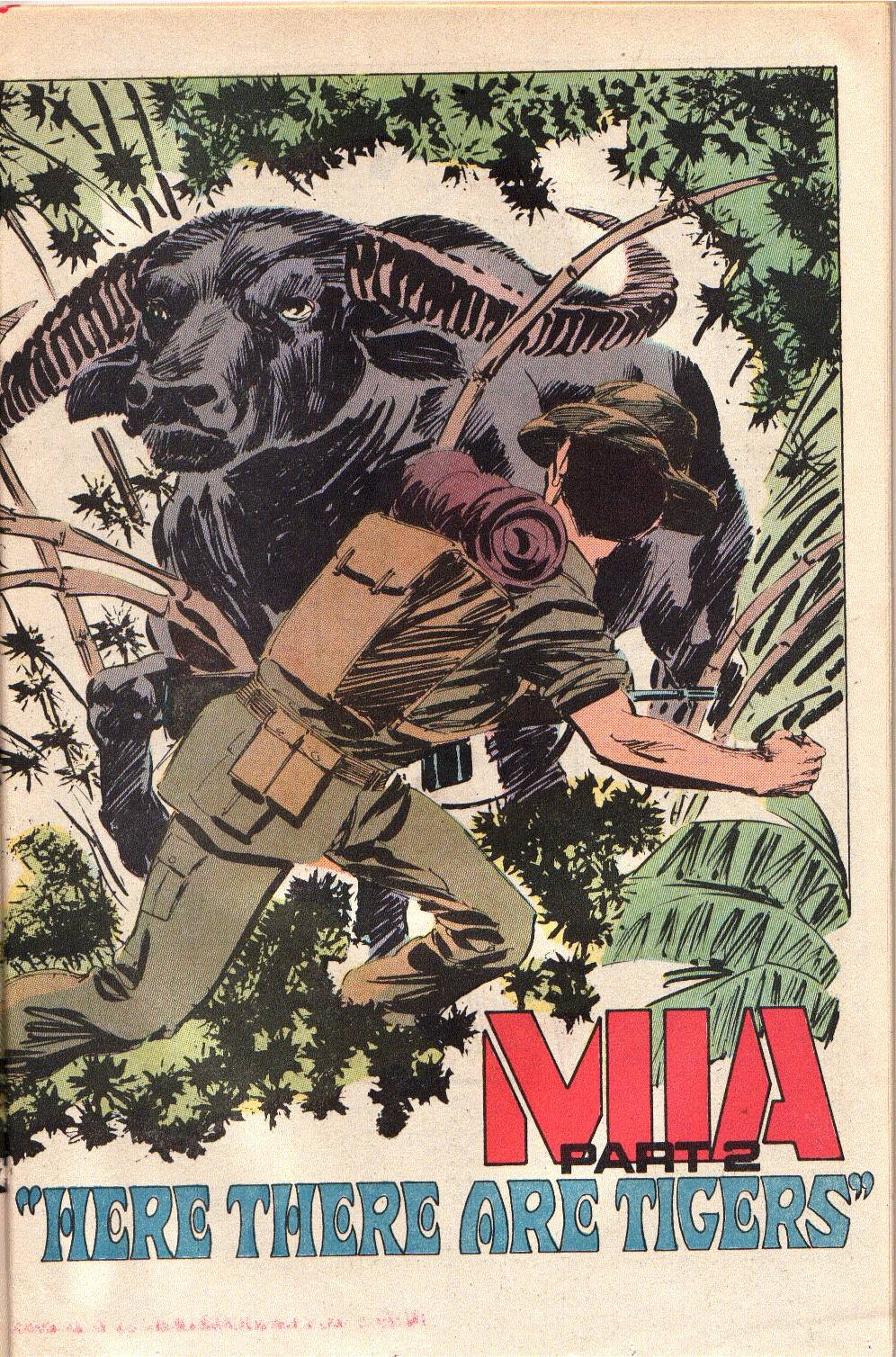 ...a water buffalo charging them. Jon takes aim with his .308 cal FN-FAL rifle and aims for the center of the forehead, knowing he has one chance at it, as the beast is moving like a freight train. he fires, and the animal goes down, but its momentum carries it into Jon. He thinks he may have cracked a couple of ribs and his fever is raging. Jerry thinks he might have a jungle virus and asks if he has been taking his quinine, to which Jon admits he lost his supply in a river crossing. jerry has extra and opens up his survival knife hilt and pours out some pills. He has quinine, antibiotics, pain killers and benzadrine....just what you need for a weekend in Las Vegas. Jerry and Maj Kong have a lot in common. Jerry talks of aborting, but Jon reminds him they can't be picked up until the 15th. Tran comes and warns them of a patrol in the area, probably heard the shot. They start to confer and Tran hisses to be quiet and they see an army patrol come into view. Jerry says to "di-di" ("Di-di mau", a Vietnamese phrase that roughly translates as "Move quickly")and they haul ass, but Jon lags behind. Tran tells him to move and Jerry says to leave him or they are all dead. Jon can barely stand and the other two disapepar into the bush. Jon finds the barrel of an AK thrust in his face... 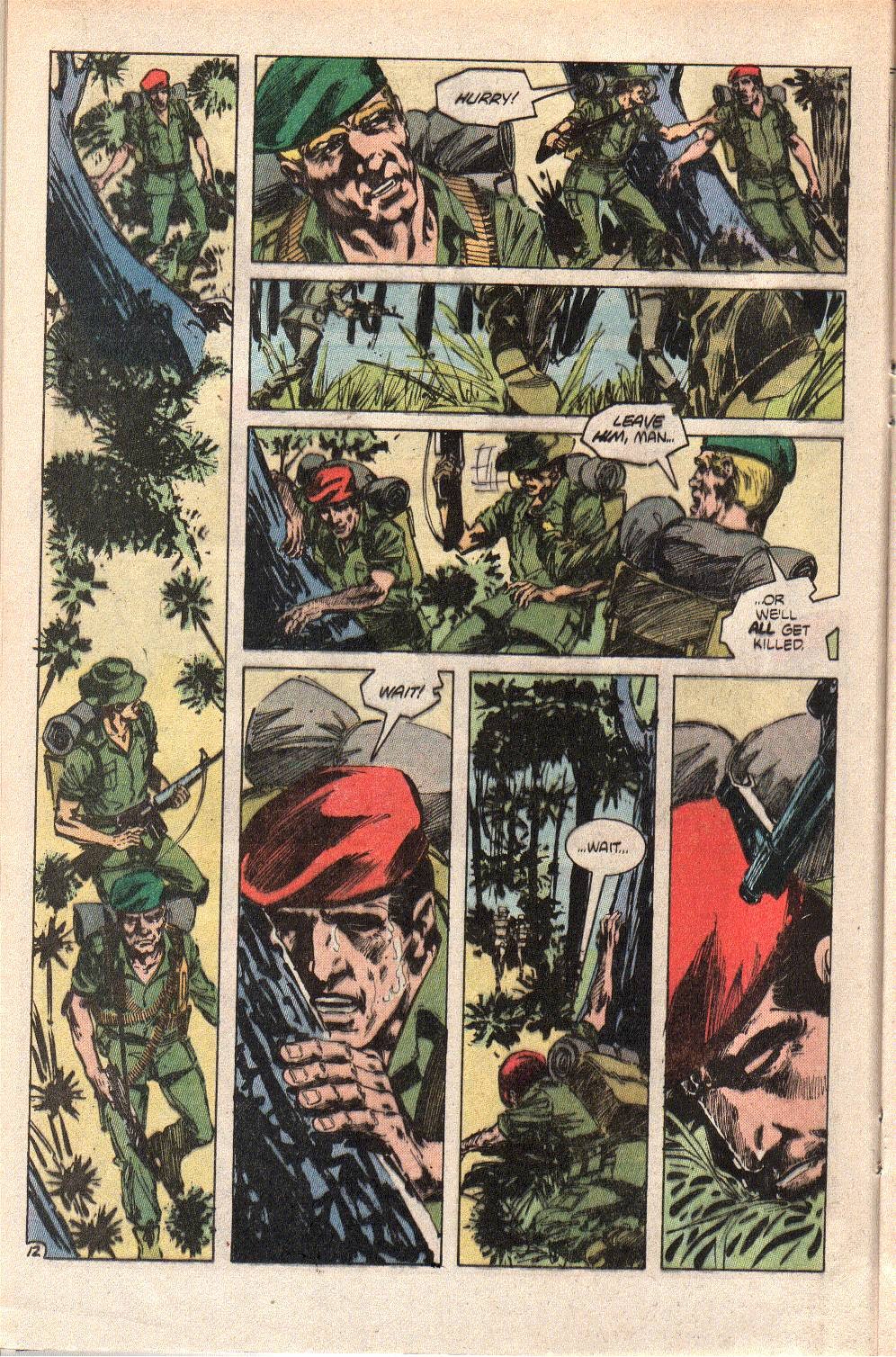 Jon is taken prisoner, bound to a bamboo pole, then beaten and interrogated. The interrogator thinks he is CIA, but Jon isn't talking. The man pulls out his knife. Jon gets some new scars. The interrogator says he is sick and there is no need for this, just talk. Jon says he hopes it is contagious and spits in his face, trying to anger the man into killing him. Jon is beaten again and strung up by his arms and left to hang for a while. We see a sentry keep watch, then a hand clamps over its mouth and the hooks of a prosthetic limb claw his throat. Another gains a hole in his forehead, with the sound of a soft thud. It is Jerry and Tran and Jerry cuts Sable down, while Tran keeps watch, holding the suppressed Colt Woodsman in his hand. Jerry slings him over his shoulder and they move out, quickly. they find a place to hole up and Jerry stiches up Jon's chest and feeds him antibiotics. he is worried that Jon has malaria. They hope he can make it to the boat extraction. Tran holds up the pistol and says it would be more merciful and Jerry thrusts it away and says Jon is his friend. Tran argues that he cannot walk and Jerry says he will carry him. Jon rides on Jerry's back, but they move more slowly than they would, without Jon. They are late and have only 30 minutes to get out to the boat. Jerry says they have to try. Tran stashes their weapons and Jerry puts Jon in a life vest. Tran also dons one and they swim for the boat, with Jerry towing Jon. They are within yards, when 0100 comes and they are not seen, in the fog. The boat starts its engine and moves off. They can't hear Jerry over the engines. Jerry drags Jon back to shore and rests. Jon wakes up, his fever broken. He asks Jerry what day it is and is told it is the 15th. He says it's his birthday... 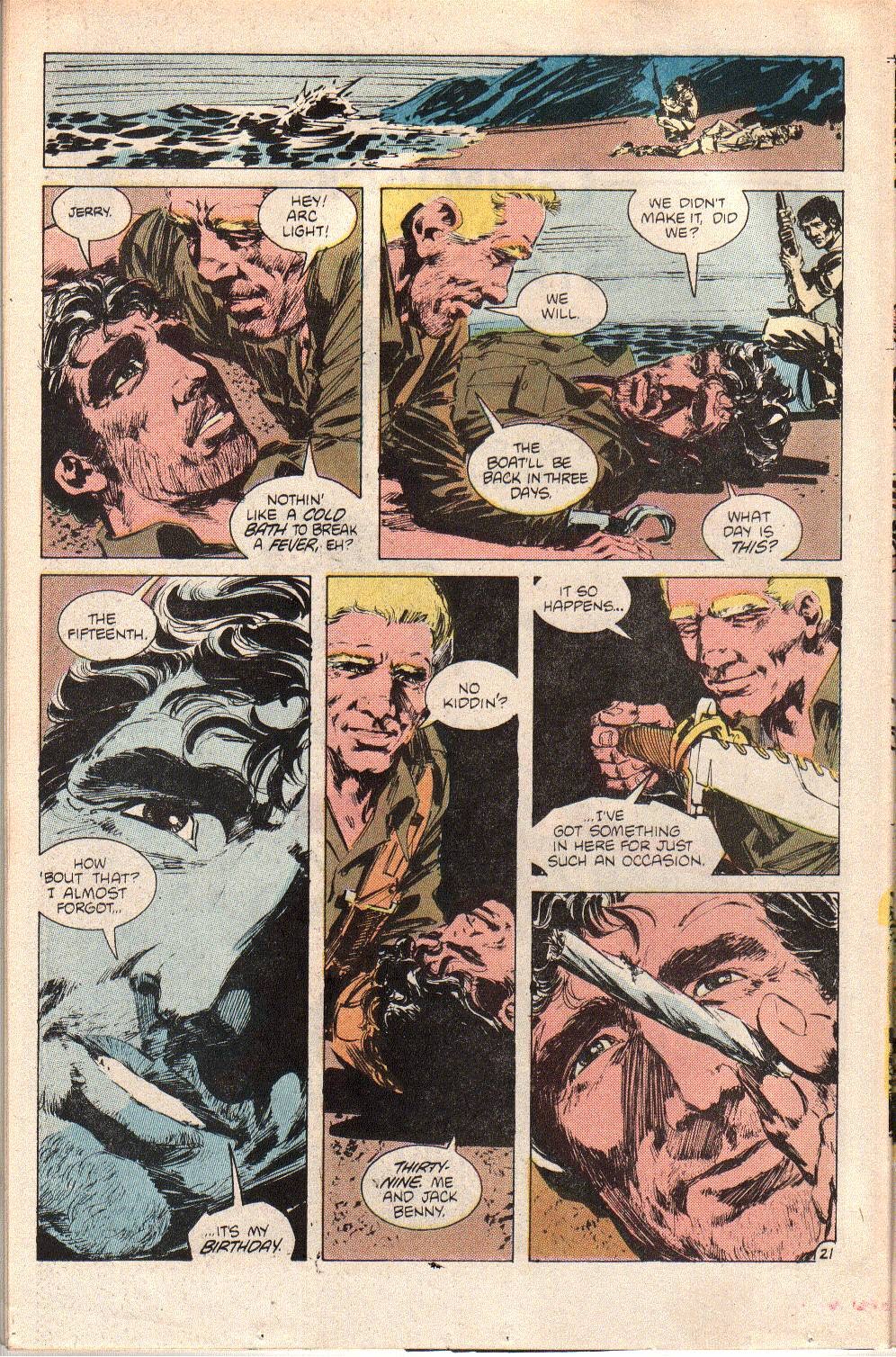 Jon wakes up again, later, and asks where they are now. Jerry tells them they are holed up in a montagnard village, where Tran had contacts. Jon asks how he got there and Jerry says Fetter Express (his surname is Fetter) and Jon laughs and apologizes for being a burden. Then he spots something. 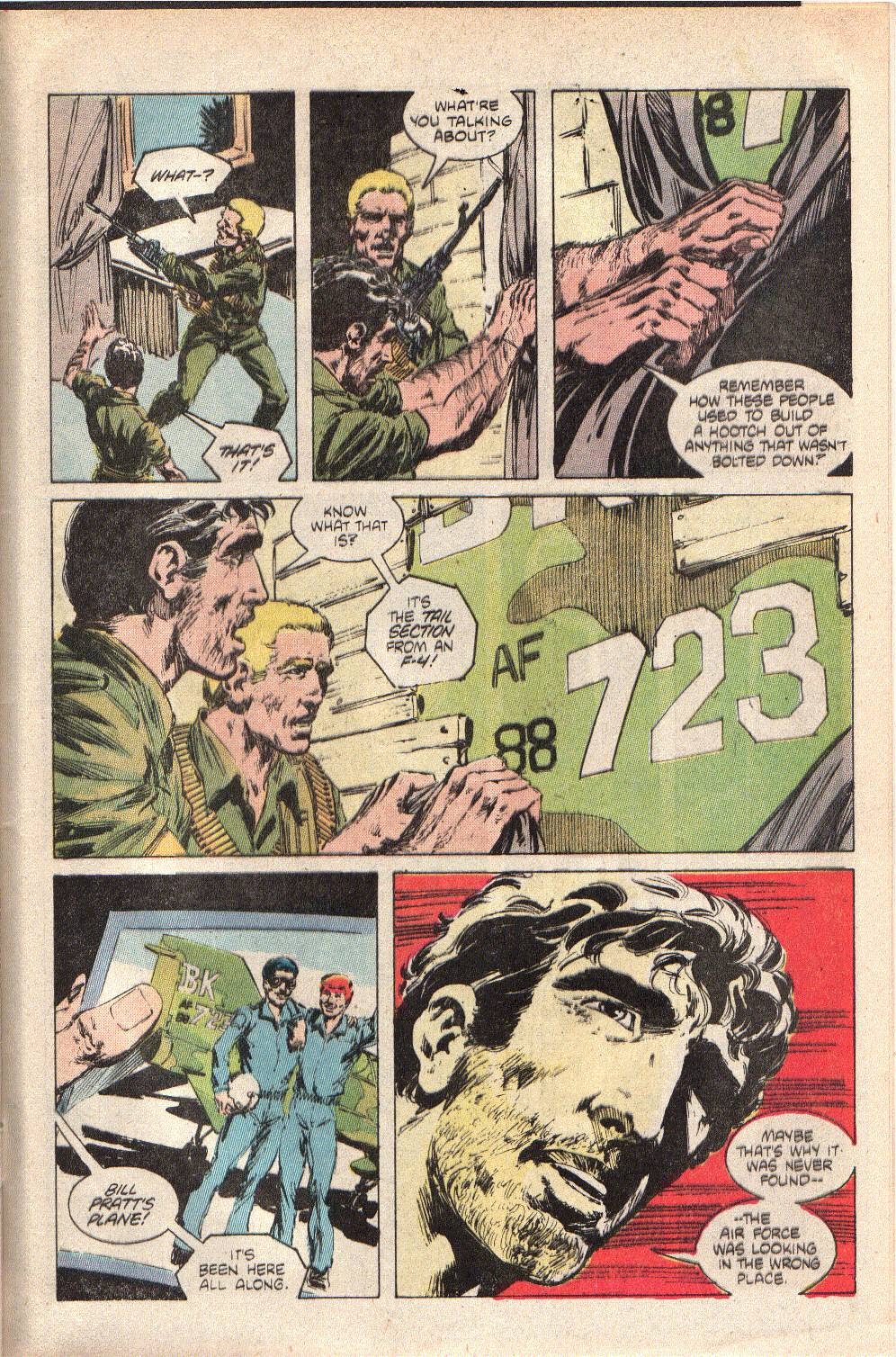 Part of the wall of the hooch was built using the tail section of an F-4 Phantom, with the registration number of Bill Pratt's plane. The Air force had searched the wrong area. They run out and yell for Tran. they have him ask the village chief about the men in the photo Jon has. The chief asks if they are there for the American pilot and he takes them to him. Tran translates as they move to a cave. The red-headed one (Rusy Olsen was captured near the DMZ. Both men bailed out of their plane, but Bill Pratt was injured and hidden in a cave. However, he died of his wounds and the chief shows the men the skeletal remains of Bill Pratt, still in his deteriorated flight suit and helmet, with his name on it. His dog tags dangle from the neck. At least Jon now has proof for Sonny and Hollis. They burry the remains and talk of what they do, when they return home. jerry will try to work it out with Sheila. Jon will put a family's mind to rest and Tran will leave his country, again, and try to start a better life, with the money he earned. They head for the next rendezvous with the boat. jerry still has to support Jon, but he is in better shape. they joke as they leave and miss noticing that a farmer working in the field is bigger than the rest and under the shadow of his "coolie" hat, he has a red beard. They miss finding Rusty Olsen. Back in New York, Jon meets with Sonny, Hollis and the kids and presents Bill's dog tags. He apologizes that there isn't better news; but, Hollis assures him that now they know, for certain, and can now grieve and move on. It is a comfort to have an answer. Jon wonders about the other families of the more than 1600 men still listed as MIA. Thoughts: No Rambo ending for Jon, just reality. The odds are likely that most of those that were listed as Missing In Action were dead, their remains unidentified, in places no one knew or marked. The war was a mess and the heat of battle causes mistakes, and there weren't always remains to identify. Some may have been undocumented prisoners, but malnutrition and disease would be a major factor in their lives. Once any political value in their lives was gone, there would be little reason to let them live. Those that might have lived, might be too destroyed to even know who they are, like Rusty, a shell of a man, tilling a field, because he had no memory of home. The villagers know he is dead inside and don't let Sable know he lives. Why bring the war back to them? let the man have his peace, for what it's worth. it's not a happy ending; it's not a Hollywood ending; but, it is a logical and realistic ending. Much of the conversations between Jon and Jerry reflect those of veterans who get back together and wonder what it was all about. Why did they survive this hell, only to come home to people who wanted to bury them away and forget the war, whether they were for or against it. The peace activists moved on, the hawks moved on. The soldiers had to live with the war. They talk of the dichotomy of hating the killing, yet feeling the adrenaline rush that came with the fear, that made them truly feel alive and relish every moment, when they weren't fighting for their life or on alert to make sure it didn't suddenly end. how do you transition to a world away from that, when that was your reality, for a year or more? There have been many theories about why the Vietnam era veterans suffered PTSD in such high percentages, relative to previous generations (including Korea). One major factor was a transition to civilian life. In World War 2 and for many in Korea, they came there on troop ships and went home on troop ships, arriving after long voyages. they had time to leave combat behind, before stepping back on American soil. The Vietnam generation, thanks to modern air travel, were often back in the US within 24 to 48 hours of a firefight (though generally guys who were to rotate out were pulled from patrols, if possible). Another theory is the duration of combat. Paul Hardcastle's 1985 hit, "19," about the Vietnam generation, includes many VA and other US Government and military statistics. The song title, itself, reflects the fact that the average age of a combat soldier in WW2 was 26; in Vietnam, it was 19. A tour of duty was one year, but soldiers could be under fire almost every single day, depending on where they were deployed. VA statistics suggested that over half of those veterans of the combat zone suffered from some form of PTSD. Sadly, the VA wasn't equipped to help and it took years of mental health professionals and the vets themselves to establish support networks to try to find some peace with the past. In 1990, filmmaker David Hoffman interviewed 180 Baby Boomers about their experiences in the 1960s, for the documentary, "Making Sense of the Sixties." This is part of the interview with poet and educator Bill Ehrhart, who served in 1st Battalion, First Marine Division from February 1967-1968. Among other decorations, he holds the Purple Heart, Navy Combat Action Ribbon, and 2 Presidential unit Citations. He was in the intelligence section, in the battalion. he articulates extremely well, what the experience was like, what he thought when he arrived, what he soon learned and how he was changed at the end. How do you come through that and pick up a normal life? How do you deal with what you did or was done to you? How do you live with the fear, anxiety and death, which was a day-t-day part of your life? And how do you explain that to someone who didn't experience the same thing? Now, imagine wanting to talk about what you've been through and being faced with an audience who doesn't want to know, because if they do know, then they have to share the horror and the guilt, because they have to question their own decisions or plain luck? From my own experiences and observations, people will say thank you, these days, they will show respect to veterans and people currently serving; but, then they tuck away the idea of what those veterans have done in the name of this country or other countries, how their votes may have affected those lives, what they have gone through and want to put them into a little glass case that they can take out on Veterans Day and parade and say thank you, and then tuck them away again. It's not a willful thing, it's not an evil inclination; it's just too big for people to contemplate and process. They haven't lived it, they don't understand. They don't have a personal stake in VA appropriations and staffing, or access to mental health professionals or support groups. They hear the news of budget negotiations and their own tax bill and they see numbers, because they have no other frame of reference. When veterans get together or meet another veteran, they talk about the things only they understand. I was lucky; I served during a war, but never saw combat. I sat in South Carolina and hunted down repair parts for our ships deployed to the Persian Gulf. I saw my generation get welcomed home. I saw people wave flags and cheer. And then they moved on with their lives. And I saw news reports about strange illnesses in soldiers who served in the combat theater, Gulf War Syndrome, until those stories were pushed away by other news. I went on with my life, without nightmares of warning sirens, and donning chemical weapons suits, or firing Tomahawk missiles at some remote target, far beyond my vision. I have read some accounts from Marines and soldiers who were in Kuwait and Iraq. Their war was a little different. A decade later, I watched in stunned silence as a plane impacted the World Trade Center, on a tv a colleague brought in from home, because we were working and hadn't heard the reports. I saw those that followed me go to war. For the last 20 years, I have seen many of them not return and many who have try to deal with the same feelings and experiences that the group before me faced; but, at least that generation that is still around has been there to help them, as best they can. And I have witnessed and received "thank yous," from people, who genuinely do thank me and others for our service. My father, a Korean War-era veteran (Strategic Air Command, in New Mexico), did not. His was the forgotten generation; they scored a tie and the only thing people know is MASH, which is really about Vietnam (in the film and tv form, not the original novel). They weren't ostracized, like many Vietnam veterans felt, nor were they cheered like my generation, or venerated, like the WW2 generation. They just were. But, he was lucky, never saw combat, rode motorcycles in the desert, got to be around huge planes, one of his childhood dreams. He became an educator, taught for 37 years, including myself and my siblings and some of the parents of my classmates. He didn't encourage me to seek an NROTC scholarship and he didn't dissuade me. He knew I had to decide for myself and live with the decision. Our experiences were similar, with both a respect for the people we served with and a disdain for bureaucracy and poor leadership, and a sarcastic sense of humor about institutional stupidity. Anyway, long diversion. Mike Grell articulates the Vietnam experience to a younger generation, as best he could, with what he knew and knew from others, while also articulating that those who protested the war were also doing their best to end the killing and bring everyone home, alive. Some used wealth and privilege to escape, others used civil disobedience to defy and others demonstrated to bring an end. Some served their tour of duty and came home with scars that could and could not be seen. Some never came home. Mike remembers those who still remained unaccounted for, hoping to spur others into demanding an accounting, so others can have peace. Similarly, Don Lomax, in his excellent Vietnam Journal, included profiles of servicemembers who were listed as Missing In Action. They and other comic book veterans of Vietnam, like Doug Murray and Larry Hama, Jim Starlin, and Dave Cockrum (serving in the Navy, but unsure if he was in the Vietnam theater or not) and Steve Englehart (drafted into the Army, as a conscientious objector and eventually honorably discharged, 2 years later), brought bits and pieces, large and small, into the world of comics, for the generations that followed. Next issue, we get back to the world of James Bond (and a little John Le Carre) as Jon tries to bring someone across the Berlin Wall. |
|
|
|
Post by codystarbuck on Sept 15, 2021 18:29:33 GMT -5
Jon Sable #14 For crying out loud, Jon; there's a gate 3 feet to your right! Indicia Gag: Mike Gold is sticking with the "so there" one. Creative Team: Mike Grell, story and art, Ken "Mike" Bruzenak-letters, Janice "Myke" Cohen-colors, Mike Gold-editor. Anyone name Mike gets to work on the book! Letters page (inside cover) has someone call the book pro-war, which is rich, given the last couple of issues. Mike Gold gives and interesting answer: "Being a veteran of the anti-Vietnam War movement, I honestly believe that no one is pro-war; not Richard Nixon, not Ronald Reagan, not Adolf Hitler. Unfortunately, some people are a lot more willing to engage in war without first employing all of their other options." "Triptych" earns high praise for its sensitive portrayal of not only a gay character, but Jon and Myke, as well. One reader had just fired off an angry missive about the portrayal of gays in American Flagg (I think that would have likely been issues 4-6, where Reuben attends a Ranger symposium and expo, in Brasilia, along with the Skokie Skullcrushers illegal basketball team. There are sequences with Brazilian drag queens and a central character that are rather pulp stereotyped. By the same token, so are the other characters and sexual orientations and appetites, with a cynical and satirical under-current. I doubt you could point to much in the way of sensitive treatment in Chaykin's work, on that series; but, then again, it's a satire. Kind of apples and oranges; but, looing at it from the point of view of someone who has had to live with societal negative stereotypes of their identity (race/religion/ethnicity/gender/whatever), I can understand why another one, without a counter-point would anger, while a far more nuanced and sensitive one would be worthy of praise. Still, you need to have context. Synopsis: Jon is at Myke and Grey's place, where Grey introduces him to ballet dancer Mischa Yurkovich, who defected from the Soviet Union. Jon then surprises Grey with his recognition of Mischa.... 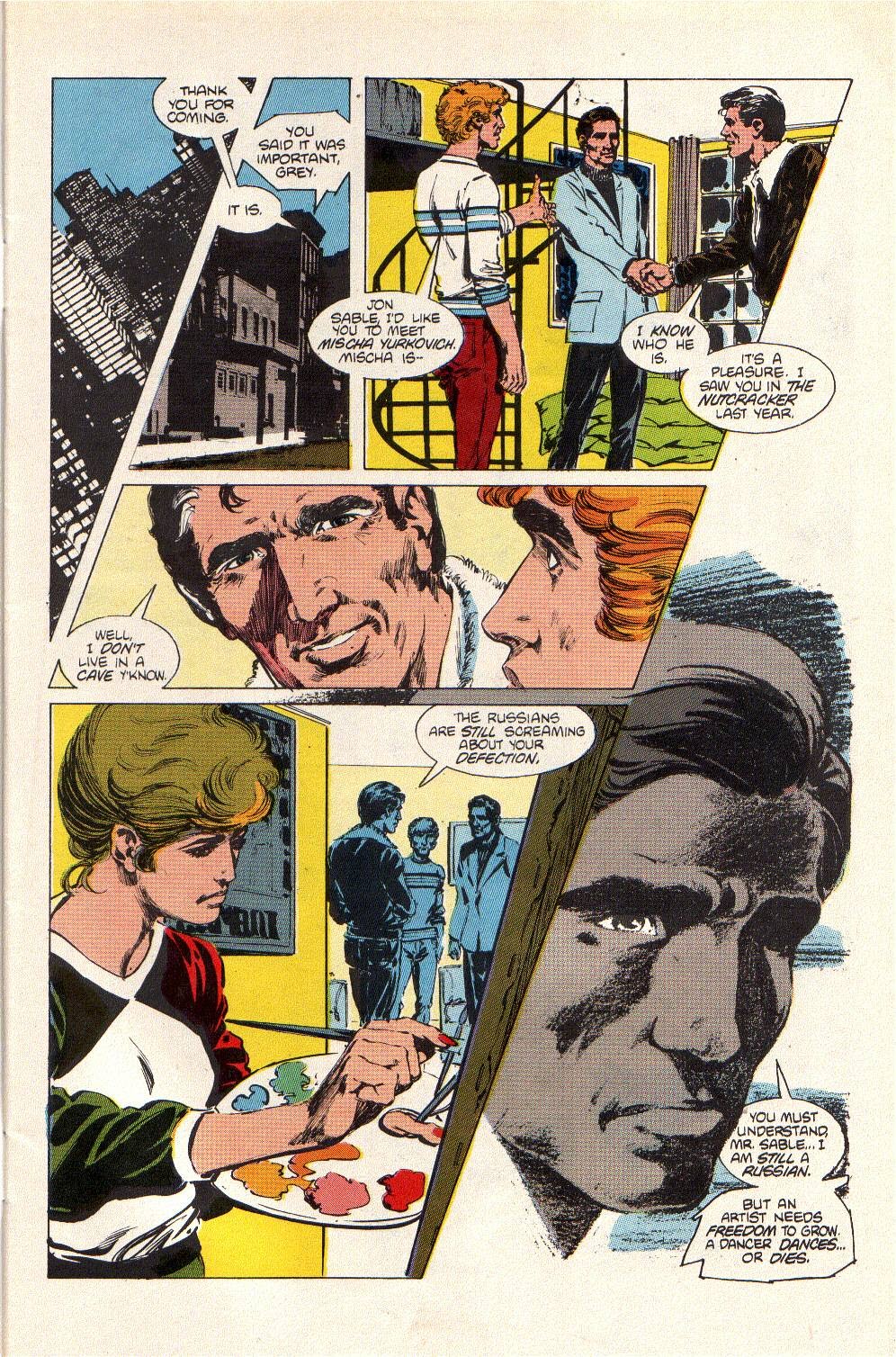 The meeting isn't just social. Mischa's wife, Anastasia, was supposed to defect with him; but, was replaced by another ballerina, at the last minute. She told her husband to go ahead, without her. Now, she is due to dance The Firebird, in East Berlin and Mischa wants Jon's help to get her across the Wall, into West Berlin and freedom. For a price, of course. Mischa leaves with Grey and then Myke asks Jon if he does anything that is not for money. he says he stopped believing in causes and she argues that his children's stories suggest otherwise. He jokes that he would dance naked, if it paid enough and Myke retorts she would like to see that. Jon flirts back, inviting her to dinner and she rejects him. He says she has him checking for warts, with her rejections and then Myke notices blood seeping through Jon's shirt. She tells Jon to take his shirt off and he dismisses it and then finally gives in and Myke sees the stiches on his chest and is horrified. Jon tells her he got the wounds by believing in causes. he explains about a war that raged, while she was young and innocent and no one understanding why it raged. he went to find an answer to a mystery and got the wounds. It isn't that he doesn't care, but charity work doesn't cover the maintenance of the equipment. Myke is quiet and then asks Jon if he has killed many people. he hesitates and answers, "Yes." She asks how many. Jon angrily replies he doesn't know. "That many," replies Myke. Jon leaves. We cut to berlin, as a vehicle approaches Checkpoint Charlie.... 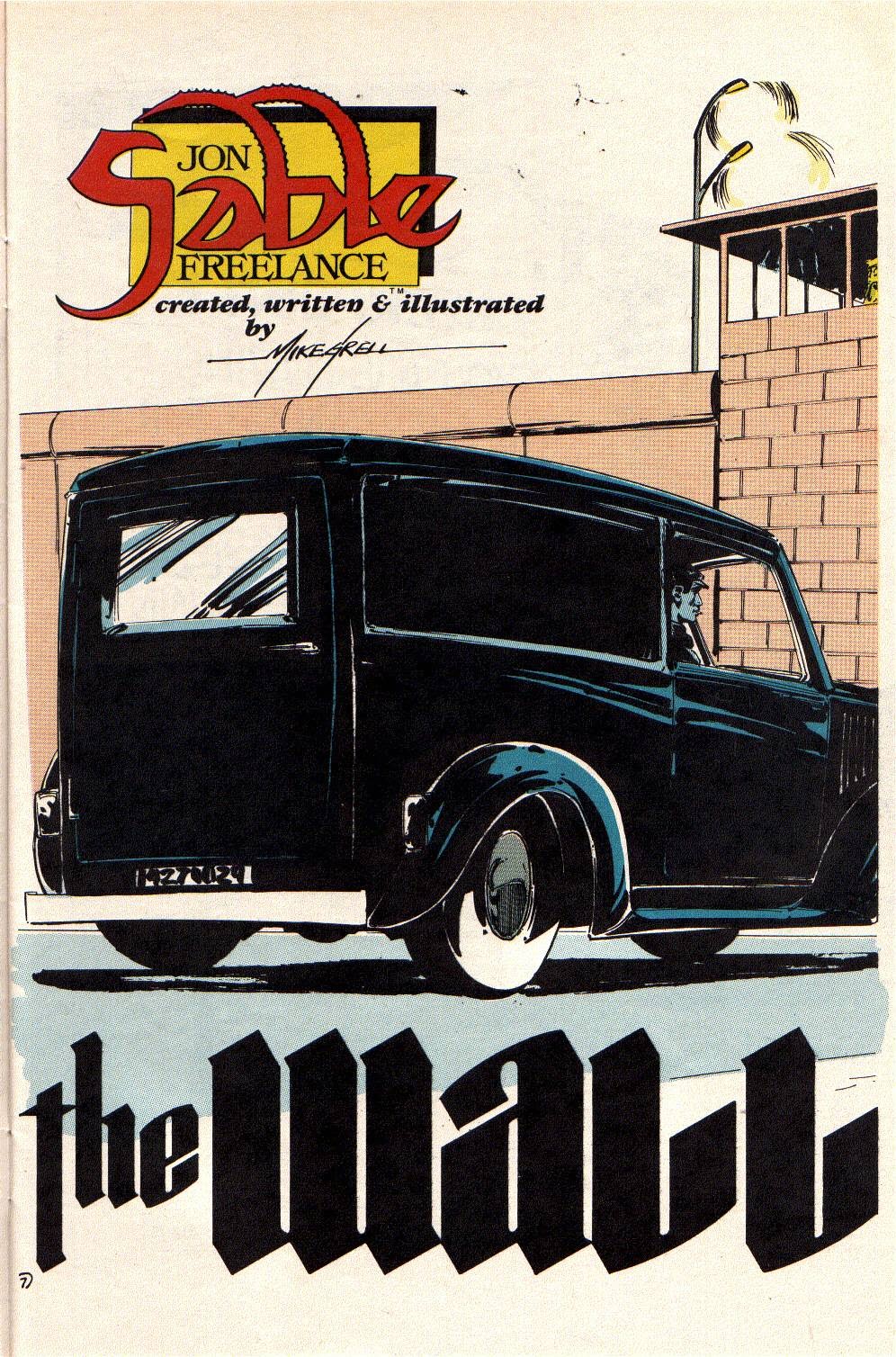 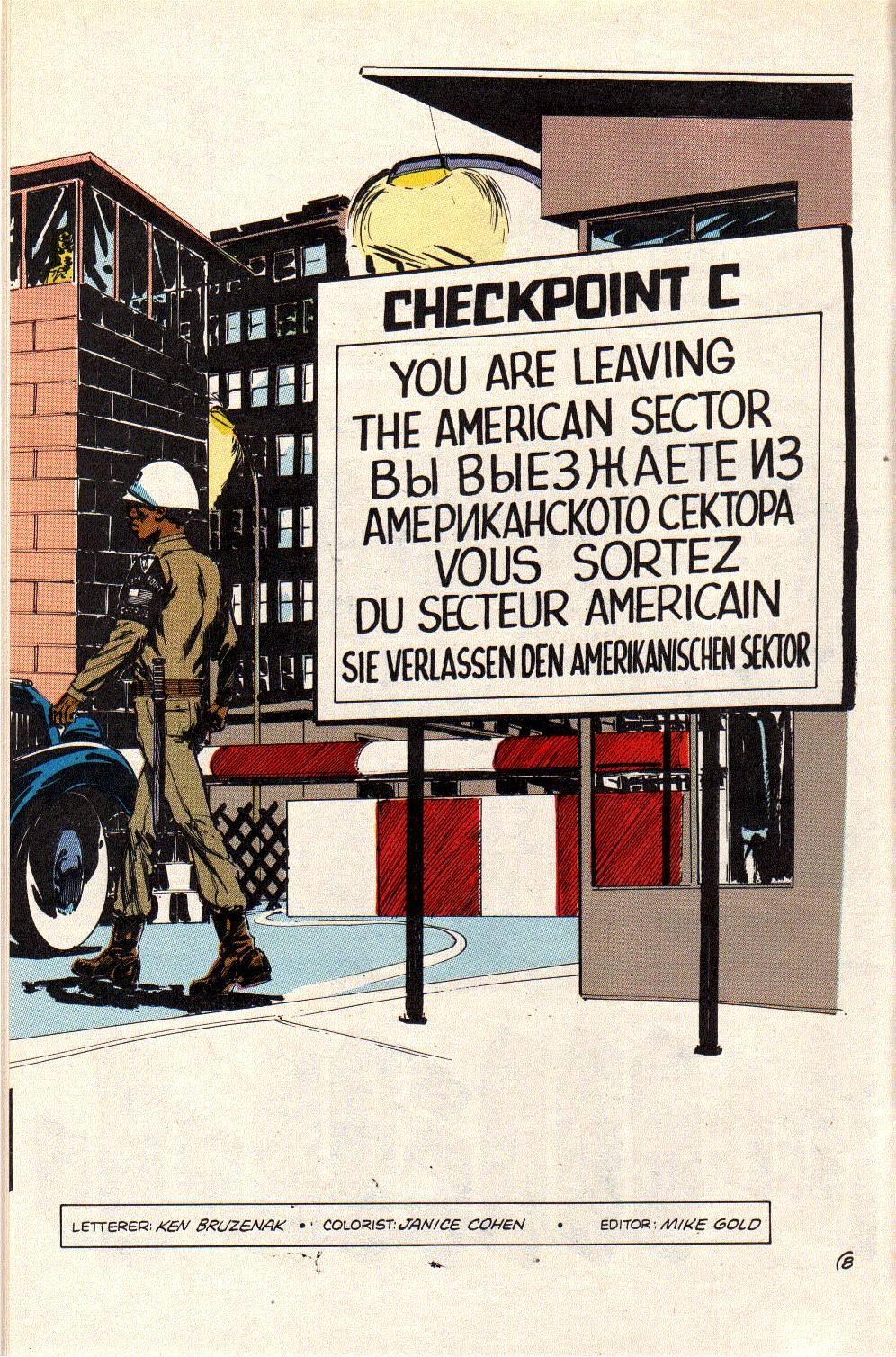 They are passed on and then face East German customs. Their vehicle is searched by a soldier (carrying an Austrian Steyr assault rifle, I must add). Another guard scrutinizes their identity cards. He gets the high sign from the soldier checking the cargo area and passes them through. Jon tells Mischa that this was the easy part. Getting out is going to be much harder. They travel to the State Opera House and park, then remove items from a hidden compartment in the roof, including a large fan and a small wheeled platform. Jon throws a grappling hook and rope up to the roof and climbs up, then hauls up the equipment. Then, Grell juxtaposes preparations for the ballet, with preparations for Jon's plan... 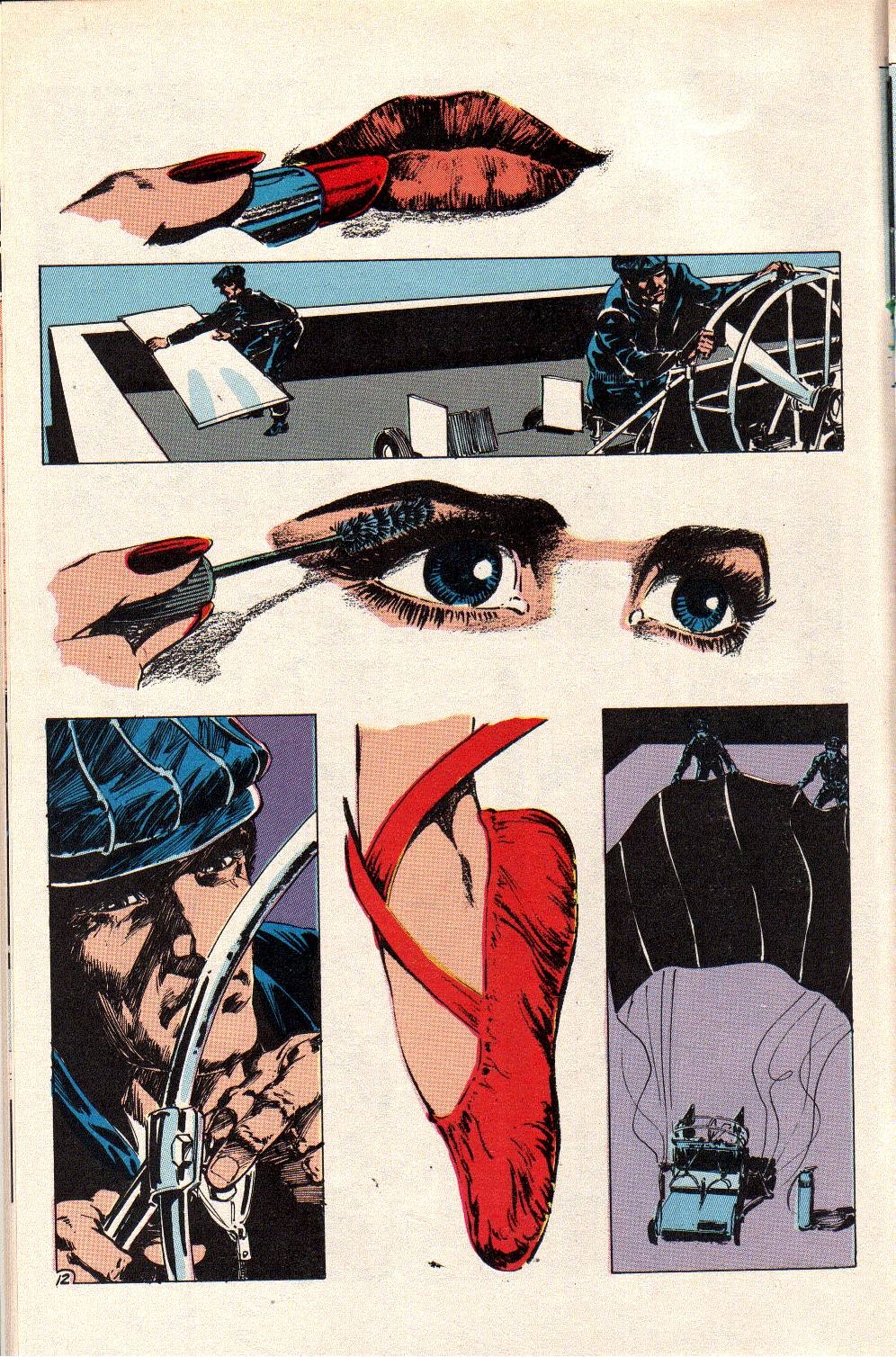 Mischa tells him that the audience is arriving and they head inside, to the overhead catwalks. They sneak down to the stage area and scout around. Mischa says they won't be able to get near Anastasia until the performance is about to begin, when a performer stumbles into the pair of them. He immediately recognizes Mischa and Jon decks him. Mischa is horrified and asked what Jon has done? He replies that he recognized Mischa. The dancer says he is Ivan and Jon replies he didn't know he was a friend. Mischa explains, no, he is the lead in the ballet, Prince Ivan! if he isn't on stage, there will be a commotion and they will be caught. They act quickly. Anastasia is on stage, as the Firebird and is soon joined by Prince Ivan.... 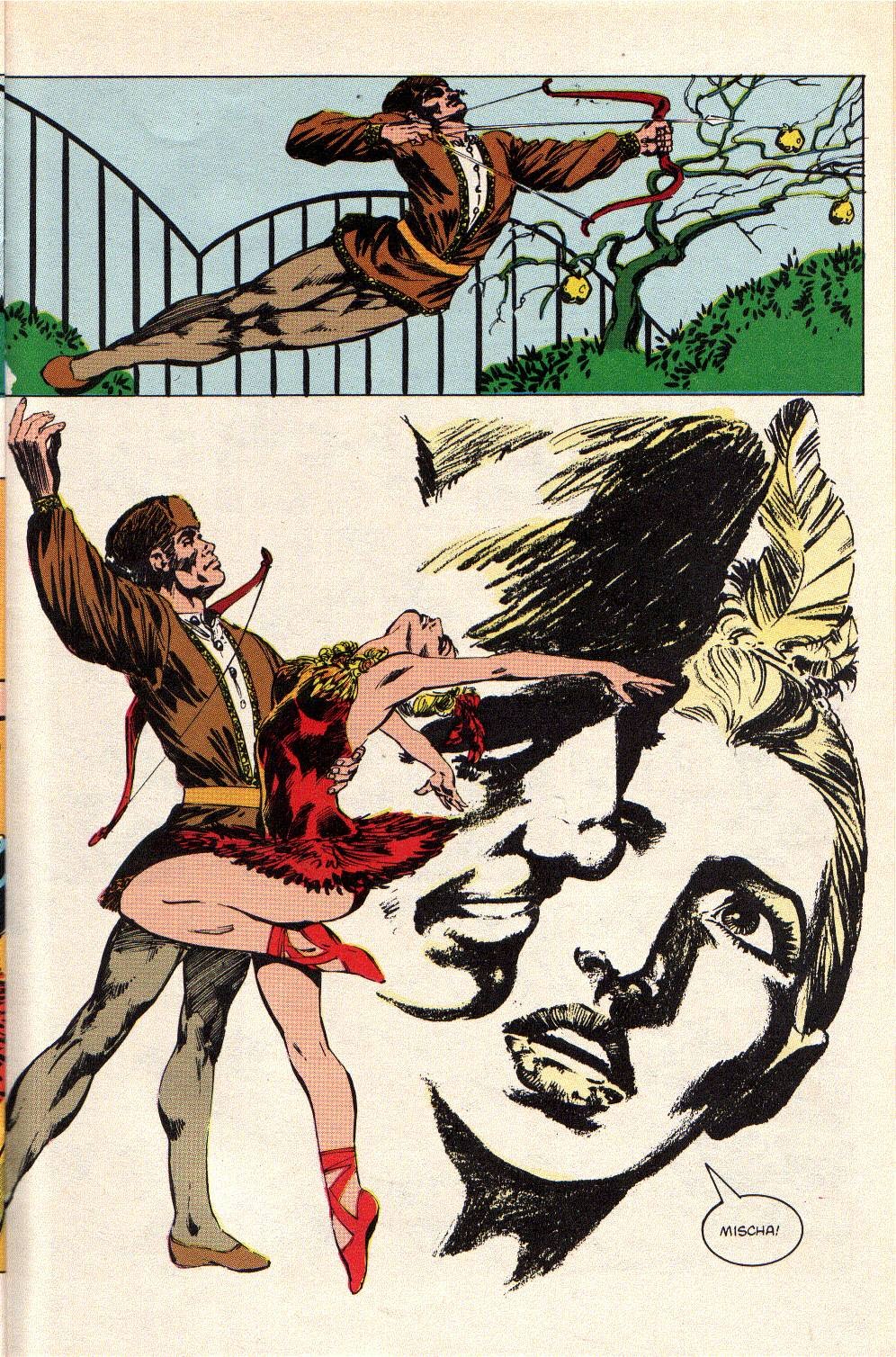 People in the audience soon recognize Mischa and word spreads. one receiver rushes out of the theater. Mischa and Anastasia dance the ballet. Jon notices a soldier at the stage door and we also see a helo fired up. The Firebird hands a sword to Prince Ivan and leaves the stage, where Jon has her get into coveralls, over her costume. Mischa dances the scene as they work. Jon and Anastasia head up to the catwalk and then out a window and up a rope, to the roof. Mischa bows to thunderous applause, as soldiers and men in suits make their way towards the stage. Mischa tosses Prince Ivan's ushanka into the crowd and people dive for the souvenir, blocking the security people. The curtain comes down, then Mischa steps onto the roll, as it is raised again for the cast to take their bows, and he rides it up to the catwalk. He then joins Jon and Anastasia. Jon puts the couple together in the wheeled cart/platform and opens a helium tank to rev up the fan engine, to high speed. He then launches what turns out to be a para-glider......  Jon pulls a large object out from under the vehicle and dons a flight helmet and buckles into a harness. We see the scrambled helicopter move in, towards the paraglider. We then see Jon's feet lift off the ground. Weapons fire from inside the helo, then Jon returns fire.... 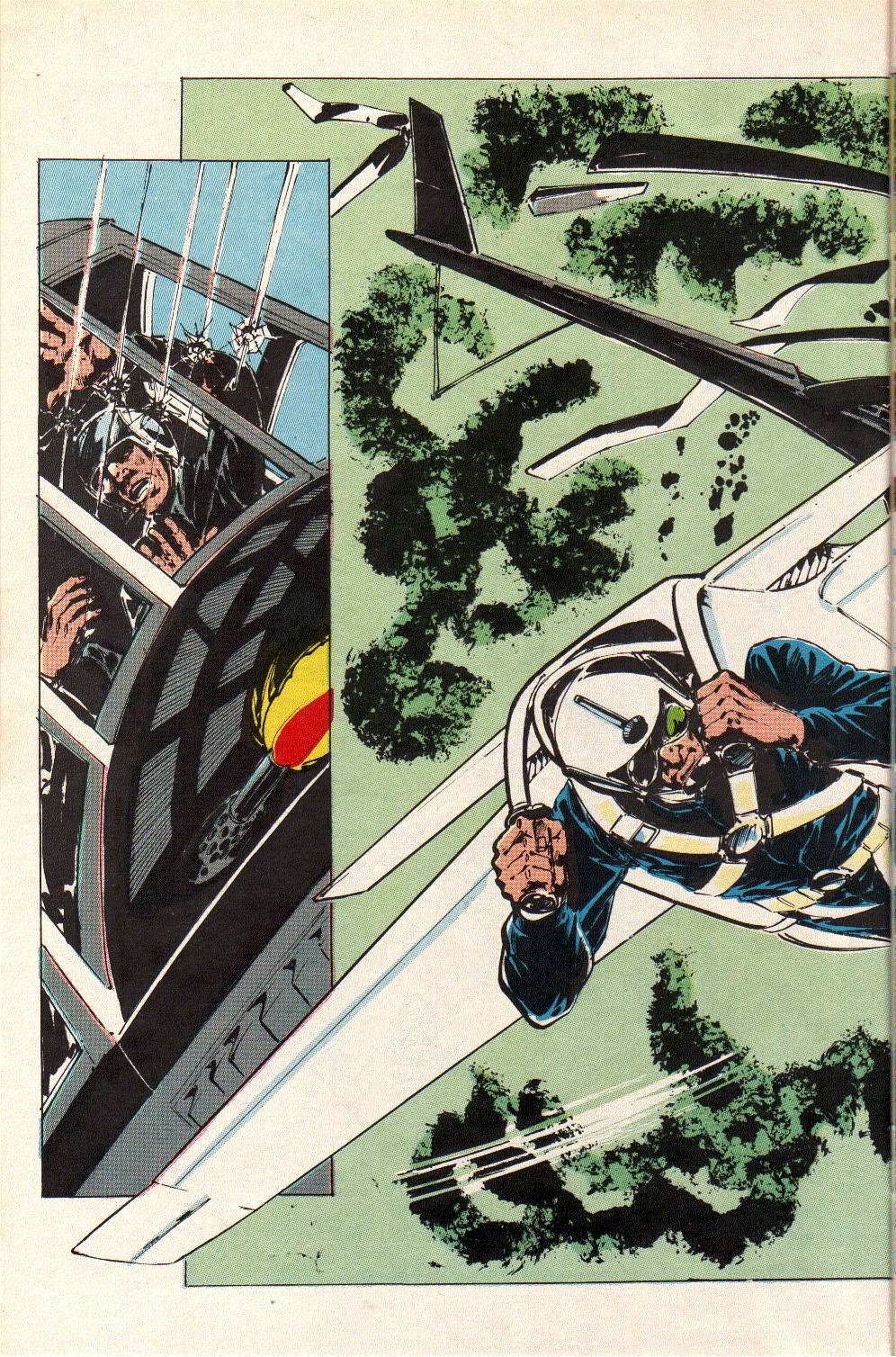 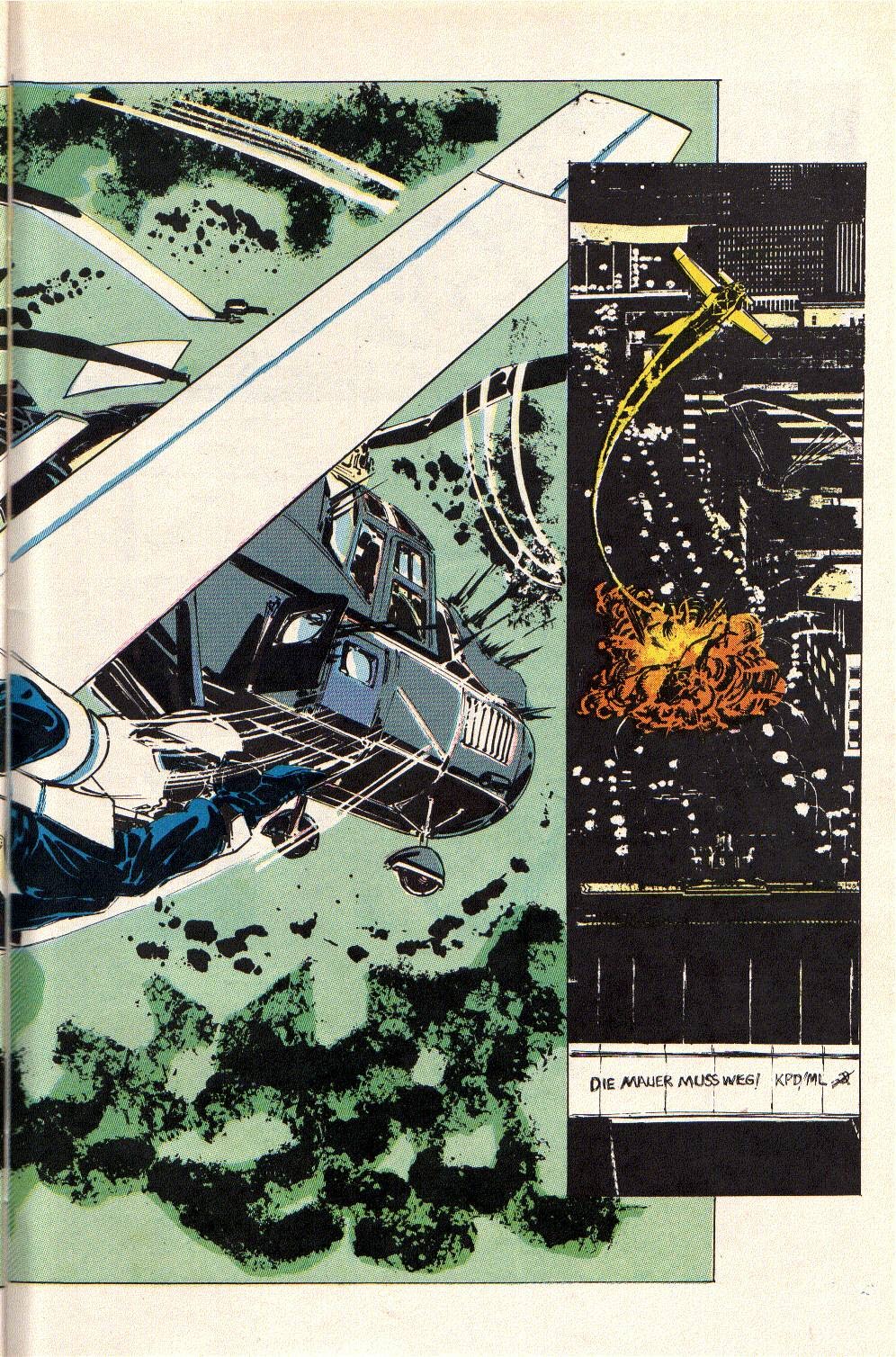 ...from his jetpack! Jon swoops ahead and shoots out a guard tower and Mischa and Anastasia land safely, in West berlin, soon joined by Jon, as he lands the jetpack. Back in New York, Jon surprise Myke, wearing a tux and carrying two tickets to the ballet, but she is on deadline. She suggests he take Grey and we end with a shot of the pair of men, watching the end of the performance. Thoughts: Well, you can't get any more James Bond then a jetpack and a paraglider, to cross over the Berlin Wall! The story is a terrific action/suspense piece, as Jon must work out a plan to get Anastasia away from the opera house and across the Wall. We see the plan unfold, rather than have it dictated to us, then watch it go wrong and lead to improvisation. We see the plan go wrong without expecting it and then Mischa has to improvise and take over as the male lead. The paraglider is a pretty good idea, as it would be lightweight, but be able to stay in the air long enough to clear the Wall and the death zone. However, it would also be a slow moving target. Enter the jetpack. This will get a lot of comment, in upcoming letters pages; but, what Mike drew was based on an actual prototype jet pack that was being developed, with a wing structure, in addition to the jet thrust. Jet packs aren't science fiction and have existed since the 1950s, when Bell developed their Rocket Belt propulsion system, which was demonstrated for the US Army, in 1961. It used 5 gallons of hydrogen peroxide to fuel a 21 second flight. that has been the chief problem holding back development of jet pack vehicles: flight time (and fuel capacity), as well as maneuverability. Further demonstrations looked impressive, but, the short flight time prevented any practical military use. the rocket pack did make it into the film, Thunderball, for the opening teaser, as pilots Gordon Yeager and Bill Suitor doubled Sean Connery, for the jet pack scenes. Powerhouse Productions did many public performances of a rocket belt, including the opening ceremonies of the 1984 Los Angeles Olympics, piloted by Bill Suitor. What Grell depicts bears much resemblance to the later successful design flown by Swiss pilot Yves Rossy, in 2006. Rossy crossed the English Channel, in 2008, in 13 minutes, after dropping from an airplane over Calais, and then parachuting to a landing, over Dover, though he was in powered flight from one coast to the other. Now, flying a jetpack long enough to get over the Wall is one thing, carrying a weapon and ammunition is quite another. Here, we are back in James Bond territory, as the caliber would have had to have been small, to carry much ammo, reducing the effectiveness of such a weapon, in flight. At best, it would have likely have been a pistol caliber. Even that would add substantial weight to the device. Still, damned if it didn't look cool! The paraglider is a variation on an ultralight aircraft. The main difference is that an ultralight has a fixed structure and wing, while a paraglider is using a parachute airfoil. Paragliders are usually just a glider, but, a fan paramotor can be used as a form of propulsion. Grell is using a combo of both ideas, making a para-cart. The wheeled platform is essentially a go-cart, with a motor replaced by the para-motor, and attached to a paraglider airfoil. The helium fires up the fan at high speed, to kick in the motor and the airfoil scoops up air, for lift. The fan then directs them towards their target. The roof launch site had a ramp to help them get airborne, as the subsequent drop helps capture air into the paraglider airfoil. I'd be interested to see someone duplicate this idea, live, as I suspect that Grell underestimates the size of the airfoil needed, based on images of paragliders....  Call it foreshortneing, for the size variance. Leaving aside the technical, this is another favorite and one of the most exciting issues of the series, from an action standpoint. we still get some good character development, in the wake of the Vietnam mission, as Myke drags out an admission from Jon that he does care about things beyond money and further horror of the price he pays on these adventures. Grell isn't rushing this romance, which is nice, as Hollywood would have had them shacked up by issue 6, at the latest (probably issue 2). What is very surprising, though there is no reason it should be, is the beauty and flair with which Grell captures the performance of Stravinsky's The Firebird. How many comics can you name that feature ballet? How many action/adventure series? Guns blazing, paragliders, jetpacks, Iron Curtain escapes and the most surprising element is a ballet, in a comic book. Grell captures the moments well, giving you a feel for the performance. I have no idea if he is a fan of ballet or just did his research; but, either way, he depicts it well, adding yet another thing that set this series above the norm. Grell does make one mistake in here, that I chalk up to a deliberate choice, for an exotic look; but, as I mentioned, the East German border guard is carrying an Austrian Steyr AUG assault rifle...  This was a highly advanced design, in 1984, used by the Austrian Army, which was a NATO member, not Warsaw Pact. It uses a "bullpup" design, where the feed mechanism and bolt are to the rear of the trigger. This allows for better aiming ergonomics, as the magazine is not in the way of the bracing arm. The weapon was designed to be ambidextrous and made extensive use of plastics, while also incorporating built-in optics, in the form of the integral scope. The foregrip could be pivoted so that it lay parallel to the barrel. The design also allowed for a shorter barrel, without loss of accuracy. Several countries experimented with bullpup designs and some adopted weapons, such as the British Army's SAE-80, the Israeli Army's Tavor, The French Army's FAMAS, and the Chinese QBZ-95. However, East Germany did not have such a weapon. As a member of the Warsaw Pact, their soldiers carried the standard AK-47, designated the MPi-KM, though manufactured within East Germany, which was known for superior craftsmanship than Soviet factories (same with Czechoslovakia). Ironically, there was another military that adopted the Austrian weapon: Australia, which no doubt drives editors of military reference works nuts. The tradition of thrillers using Berlin Wall crossings goes way back, in espionage fiction, with the best known being The Spy Who Came in From The Cold, by John Le Carre, published in 1963. That story begins with a botched crossing, which leads to the intelligence officer, Lemas', decline and eventual recruitment by the Soviets. The film version, with Richard Burton, features the tense botched crossing at the beginning and a much longer attempt, at the climax. Len Deighton also went into that realm, in 1964, as the spy protagonist (unnamed in the novel) has to work out the crossing of a scientist, which is part of a bigger operation. The film version, with Michael Caine, is the sequel (as is the novel) to the IPCRESS File. It features Harry Palmer tapped to bring out a Soviet KGB colonel, across the border, using a hearse. All is not what it seems. At the start of the film, there is an exciting escape, via a crane bucket, by a concert pianist, to establish the danger of the Wall crossing. Le Carre's later Smiley's People, the third of the Karla books, features a climactic border crossing, though under disguise, rather than spectacular method. The Berlin Wall was a major symbol of the divide between the Soviet sphere and the west and, during its construction, was the sight of many spectacular attempts to cross into the West... Grell depicts Checkpoint Charlie, the crossing point between the US sector and the Soviet sector, in Berlin. It has been the sight of many dramatic incidents, in fiction and reality... Grell ends on a joke, as Jon ends up taking Grey to the ballet, instead of Myke, again. Next issue will pick up from that point, before moving on to the next adventure. Grell doesn't make a big deal about Grey being gay; we know this from "Triptych," so there is no need. if you were new to the series, the letters page, with commentary about that previous story, told you what you needed to know; or, if you skipped the letters page, you could make your own inferences. This isn't the last we will see of Mischa and Anastasia, though that is further down the road. Next time, we head into Nicaragua with an adventure that even First's marketing said was Harrison Ford country
|
|
|
|
Post by codystarbuck on Sept 15, 2021 18:46:24 GMT -5
ps Actually, as I look at the panels again, I'm not sure that Grell isn't actually suggesting that the parachute is actually a gas envelope, which is inflated by helium, to create the airfoil. I assumed he was using helium as a boost to the fan engine, to get higher revs, for take-off (like a nitrogen boost, in a car). What he draws looks like a standard paraglider or powered parachute airfoil, not a helium balloon design.
This is one of the reasons I would love to sit down with Grell and get commentary on some of these issues, to verify technology or equipment used or homages and influences.
|
|
|
|
Post by foxley on Sept 16, 2021 3:22:45 GMT -5
ps Actually, as I look at the panels again, I'm not sure that Grell isn't actually suggesting that the parachute is actually a gas envelope, which is inflated by helium, to create the airfoil. I assumed he was using helium as a boost to the fan engine, to get higher revs, for take-off (like a nitrogen boost, in a car). What he draws looks like a standard paraglider or powered parachute airfoil, not a helium balloon design. This is one of the reasons I would love to sit down with Grell and get commentary on some of these issues, to verify technology or equipment used or homages and influences. My read on it was that it was an inflatable para-sail, using the helium to give it extra lift, given they were doing a very short take-off from the roof of the theatre. The boost idea never occurred to me, but I'm not mechanically minded. |
|
|
|
Post by codystarbuck on Sept 16, 2021 11:25:23 GMT -5
ps Actually, as I look at the panels again, I'm not sure that Grell isn't actually suggesting that the parachute is actually a gas envelope, which is inflated by helium, to create the airfoil. I assumed he was using helium as a boost to the fan engine, to get higher revs, for take-off (like a nitrogen boost, in a car). What he draws looks like a standard paraglider or powered parachute airfoil, not a helium balloon design. This is one of the reasons I would love to sit down with Grell and get commentary on some of these issues, to verify technology or equipment used or homages and influences. My read on it was that it was an inflatable para-sail, using the helium to give it extra lift, given they were doing a very short take-off from the roof of the theatre. The boost idea never occurred to me, but I'm not mechanically minded. Looking at the panel where Mischa and Anastasia are sitting in the cart, right after you see Jon open the valve on the helium bottle, the airfoil is hovering above the cart, which seems to indicate it was filled by the helium. Otherwise, they would need wind to lift a standard paraglider airfoil, and the fan wouldn't be big enough to generate what they need. I was thinking that forward motion of the cart, from the revved up fan might have caused enough air to be capture; but, in retrospect, I think it is the balloon idea. That would explain why we see it above the cart, before it moves forward to the ramp. |
|
|
|
Post by codystarbuck on Sept 16, 2021 11:28:21 GMT -5
I also recalled why Grell might have given the East German soldiers the AUG rifle; it was seen carried by the same country in the James Bond movie Octopussy, in 1983, just a few months before this came out. That film also had the Russians using a French Aerospatiale helicopter, since it looked different from the usual Bell Jet Ranger helicopters seen in previous films.
|
|
|
|
Post by codystarbuck on Sept 18, 2021 21:00:18 GMT -5
Jon Sable #15 Jon Sable makes like Indiana Jones; but the Jovitos have gunships! Indicia Gag: All Payments must be in US funds (re: subscriptions). If we had to figure outthe exchange rate on a daily basis, we'd be bankers and wouldn't have time for your subscriptions! Creative Team: Mike "Wisconsin" Grell-story & art, Ken "Pennsylvania" Bruzenak-letters, Janice "New York" Cohen-colors, Mike "Illinois" Gold-editor The letters page has people how "Jon" is pronounced (Jon or Yon; Mike Gold says, "Mr Sable, sir!"), another writer regards them as fascists and only Howard Chaykin is propping up First Comics (I'd be interested to see who was selling better then, Mike Grell or Howard Chaykin), another wants Jon to be sent to Lebanon and Mike Gold writes an editorial about Ronald Reagan threatening to ignore a Congressional resolution to withdraw US peacekeeping troops from Beirut (4 months after the bombing of the Marine Barracks, in Beirut, that killed 241 Marines). Um, I don't think one guy and a Mauser was going to sort out the Lebanese Civil War. Synopsis: Jon and Grey finish up their ballet "date"...... 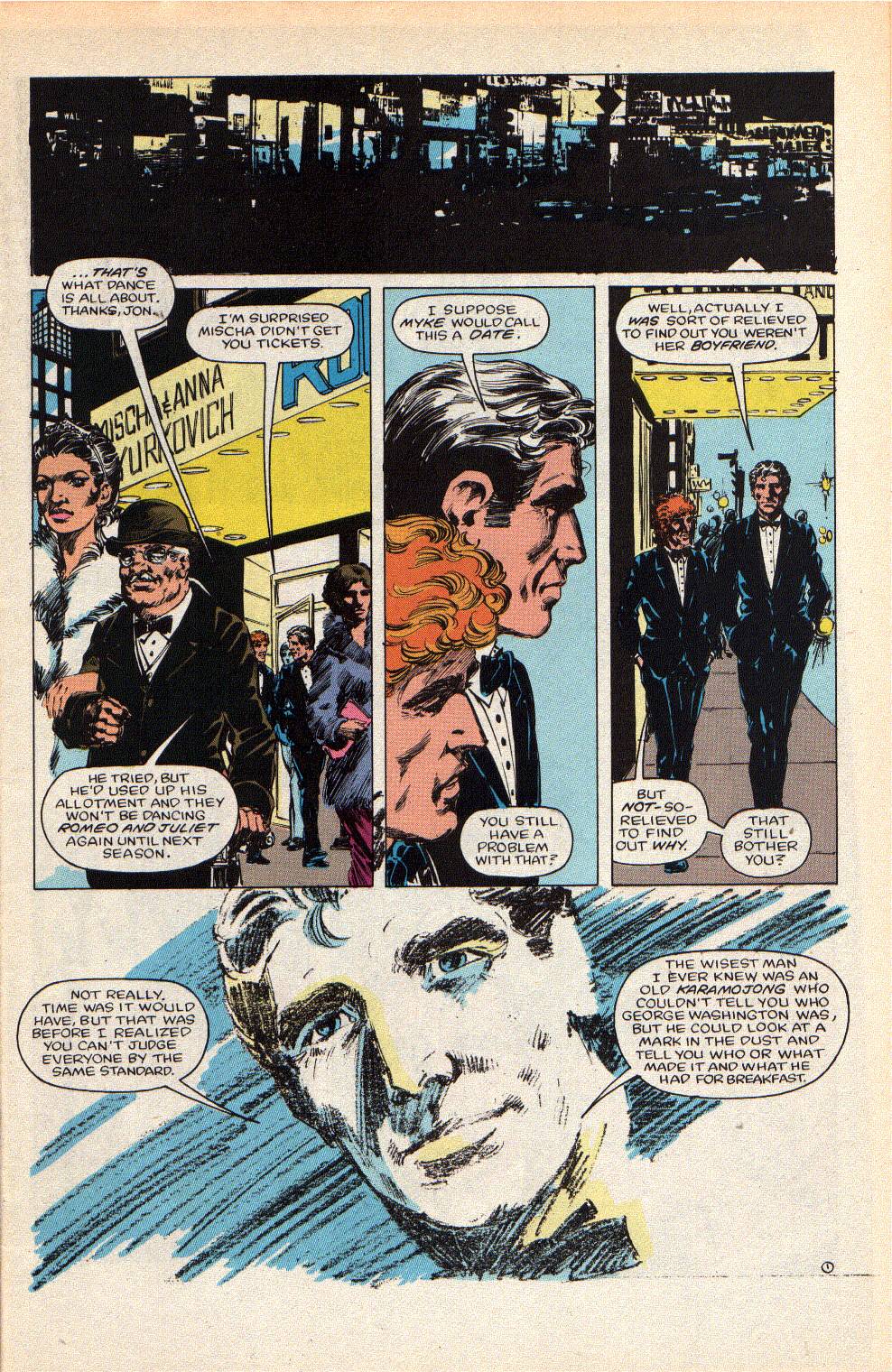 Jon is more comfortable being out with Grey, until they run into a friend of Grey's who is a bit jealous and Grey laughs at Jon's dismay. They then turn a corner and run into a group of young men, who do not look friendly. They are in tuxes and the gang is wearing colors, and it doesn't look good for the two white dudes, until Grey challenges the guy with the boom box to a breakdance-off....  Shabadoo is pleased and Jon and Grey live to boogaloo in a sequel.... Did you spot Jean-Claude Van Damme, in the crowd? Breakin' Deaux, Kung Fu Electrique! (They used to play that song in the stadium, at the Fighting Illini home football games, when I was in college) Later, Jon is writing, at his place, when he gets a ring at the doorbell, from Meissinger's Messingers (two-panel joke) and Jon signs for a letter (while hiding his Mauser in the back of his waistband, which means the barrel is probably practicing proctology) and it is a request for a meeting with Dr SE Maxwell, at the American Museum of Natural History. Jon heads over ther for the meeting and some playful banter.... 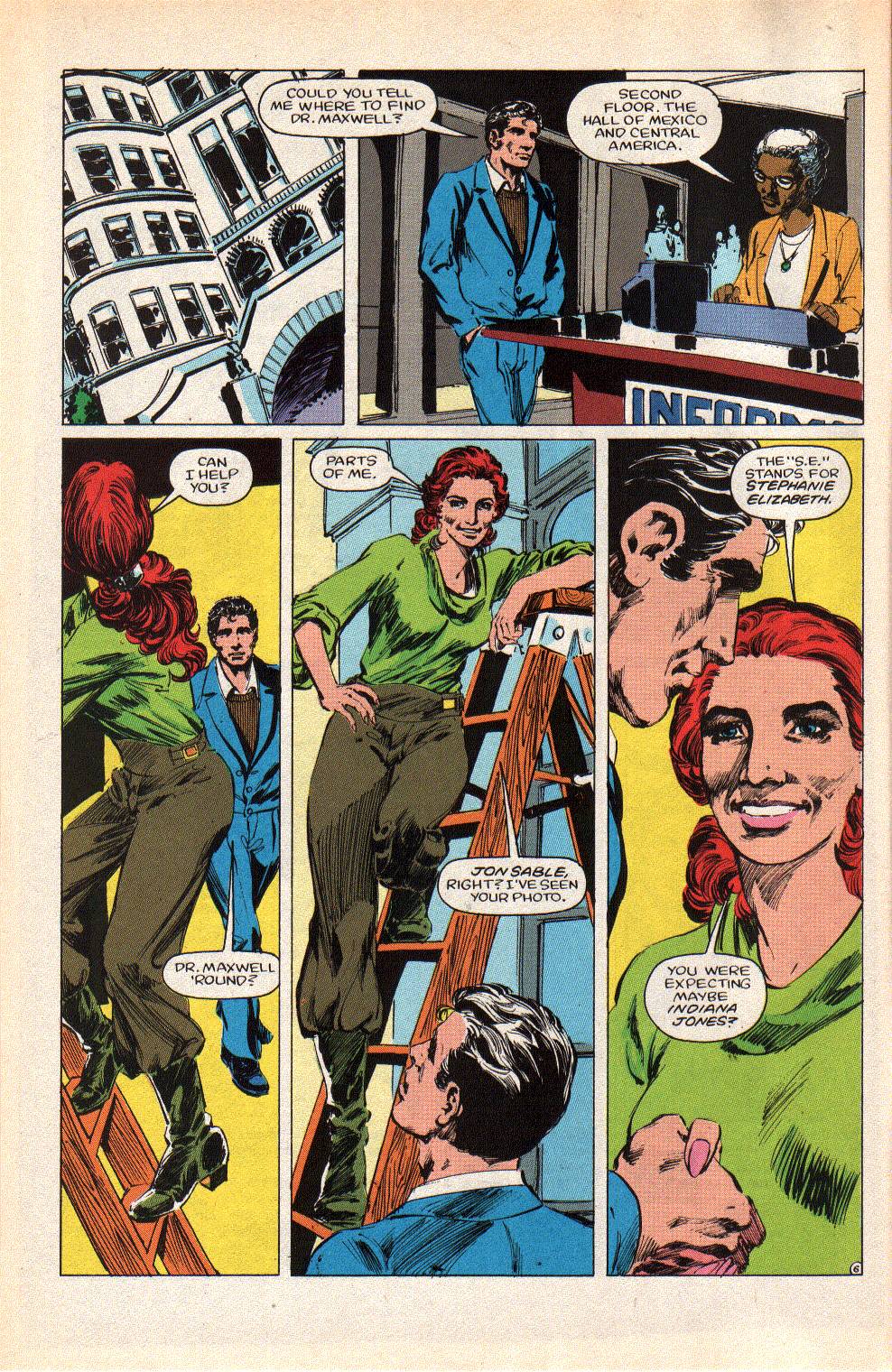 Not Grell's best; also not to sure about his couture. Think he needed some more time working with Dale Messick! Dr Stephanie Elizabeth (Stephie Beth, to her friends) Maxwell, shows John a gold sic, hidden inside stone segments, that was discovered in Teotihuacan, in Mexico. It is actually Incan, which makes it a major find. The Doc then delivers the kicker.... 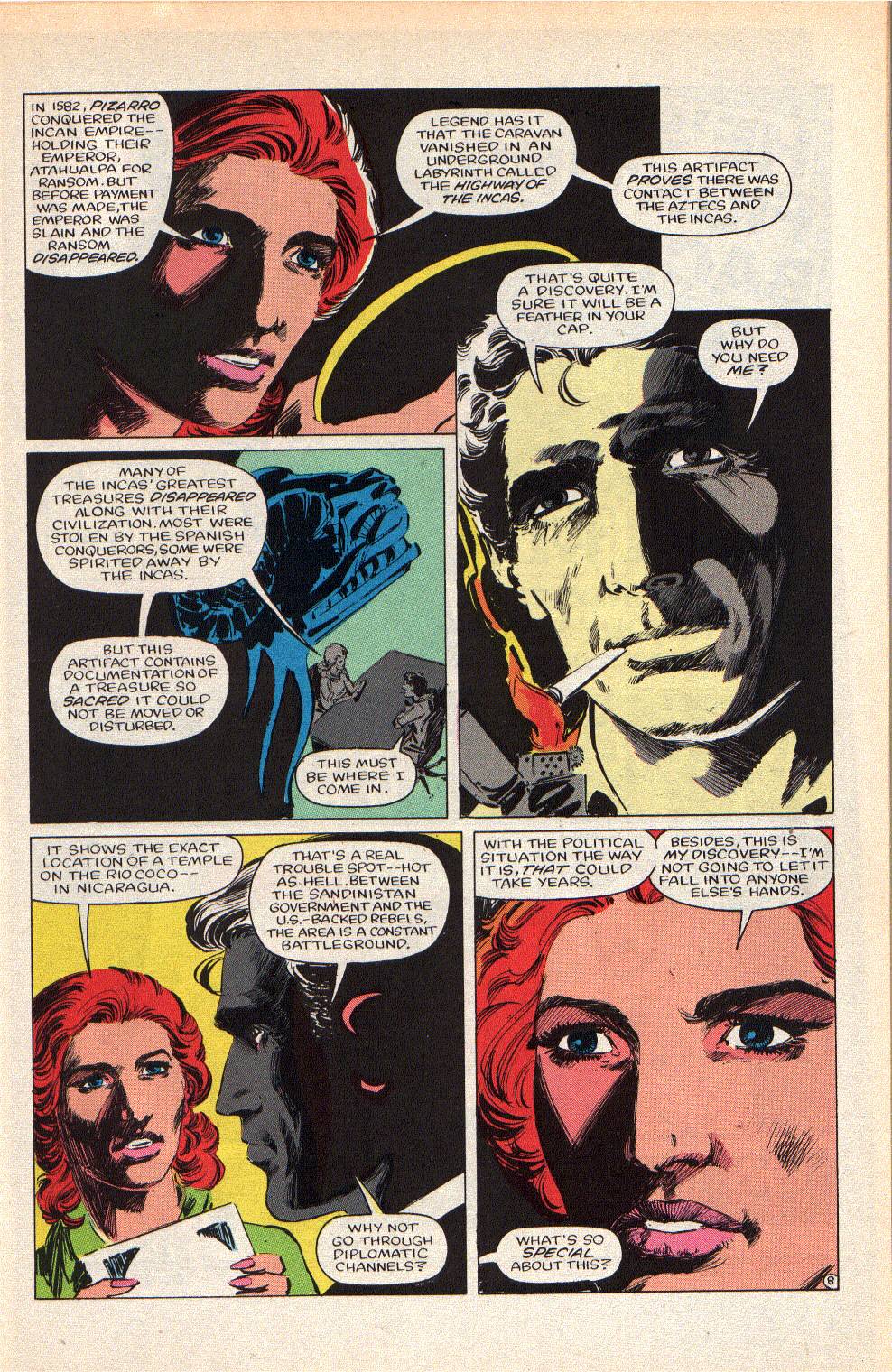 The temple they are looking for is in Nicaragua, where the US is backing the former Samosistas, as the Contras, against the Sandinistan socialist government (since it was the US that put the Samosa family in power, in the first place). Um, yeah, Indy didn't go into a war zone (well, it wasn't one, yet). Steph is looking for an answer to Aztec and Incan tales, dating from the First century AD, about a bearded, white god and says the the other side of the disc says "Beware the Perils that Guard to Crypt of the Sun God.' She believes it is the tomb of Jesus.  Ummmmmmmm........................I don't know that we have considered all of the possibilities here........................ Jon agrees to go (The man is looking to die! This is a lot of risk for a story that reeks of pseudo-science and not archeology). Later, down in Central America, Jon checks in with the Doc.... 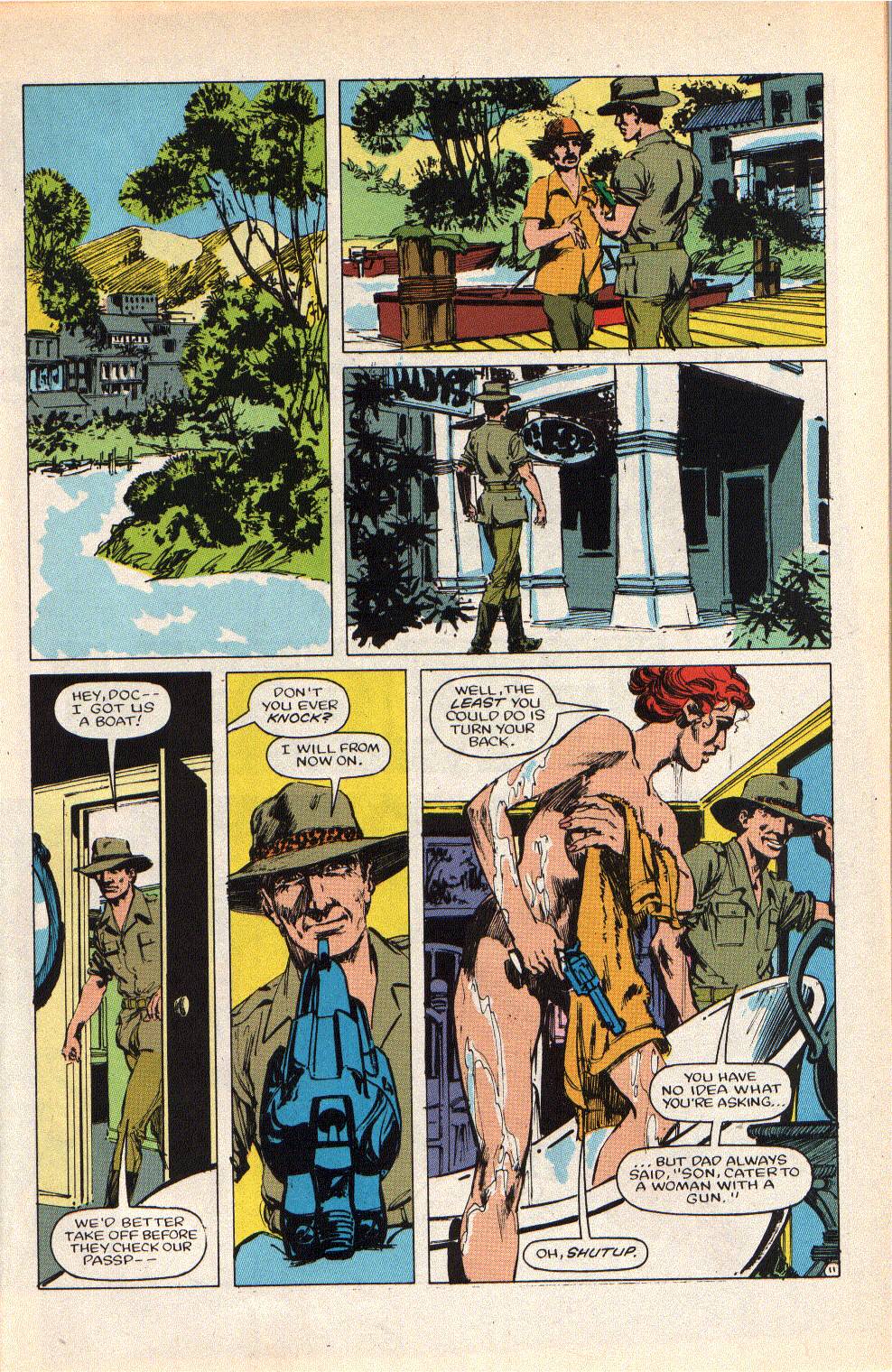 They head down a river and this turns into The African Queen (or, maybe, The Latin Queen). Bogie tells Hepburn to shut up, because he heard something. They hide under an overhang, near the river bank and a government patrol goes by. They decide to head overland and avoid their motor. They start climbing a cliffside, when a CH-53 Super Stallion flies by and the head into the bush, to hide. They just happen to stumble upon a temple and the Doc runs for it and Jon has to tackle her, before she is cut down by gunfire, from the circling helicopter. They hustle down steps inside the temple. The steps go deeper and deeper and the follow them down to a chamber. They find a socket for the golden disc and an overhead window, where light on a certain day, at Noon, would reflect light to show which is the correct chamber. However, they have no sun and the Doc thinks they are sunk, until Jon pulls out a flashlight and holds it at the 12 O'Clock position (why didn't Charlton Heston or Harrison Ford think of that.... 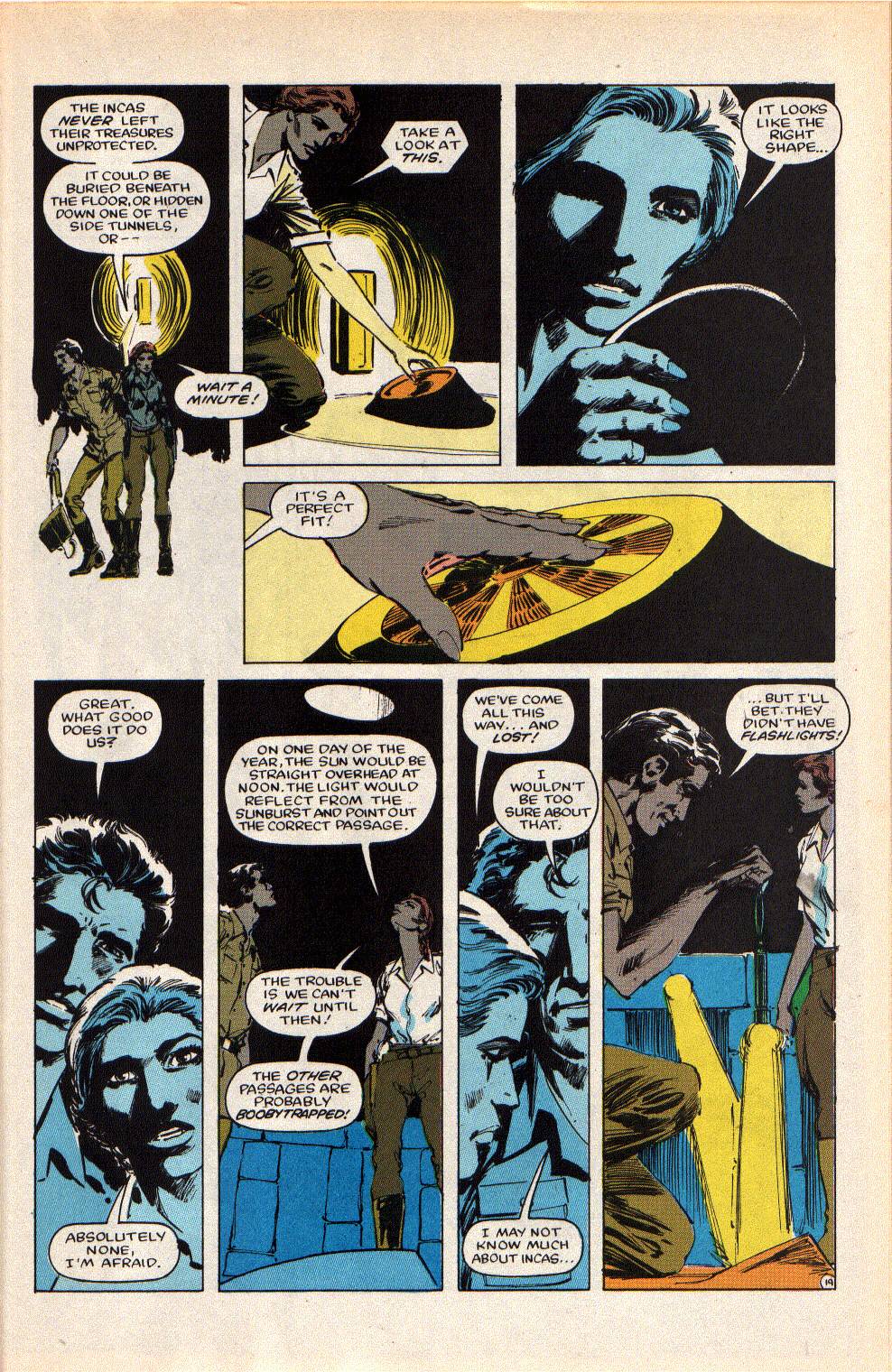 Oh, wait, Chuck did! Indy didn't! Guess that's why Lucas & Spielberg didn't get sued. They crawl past boobytraps, while the army turns up at the temple entrance. Steph finds the chamber of the white god, but it isn't a Hebrew.... 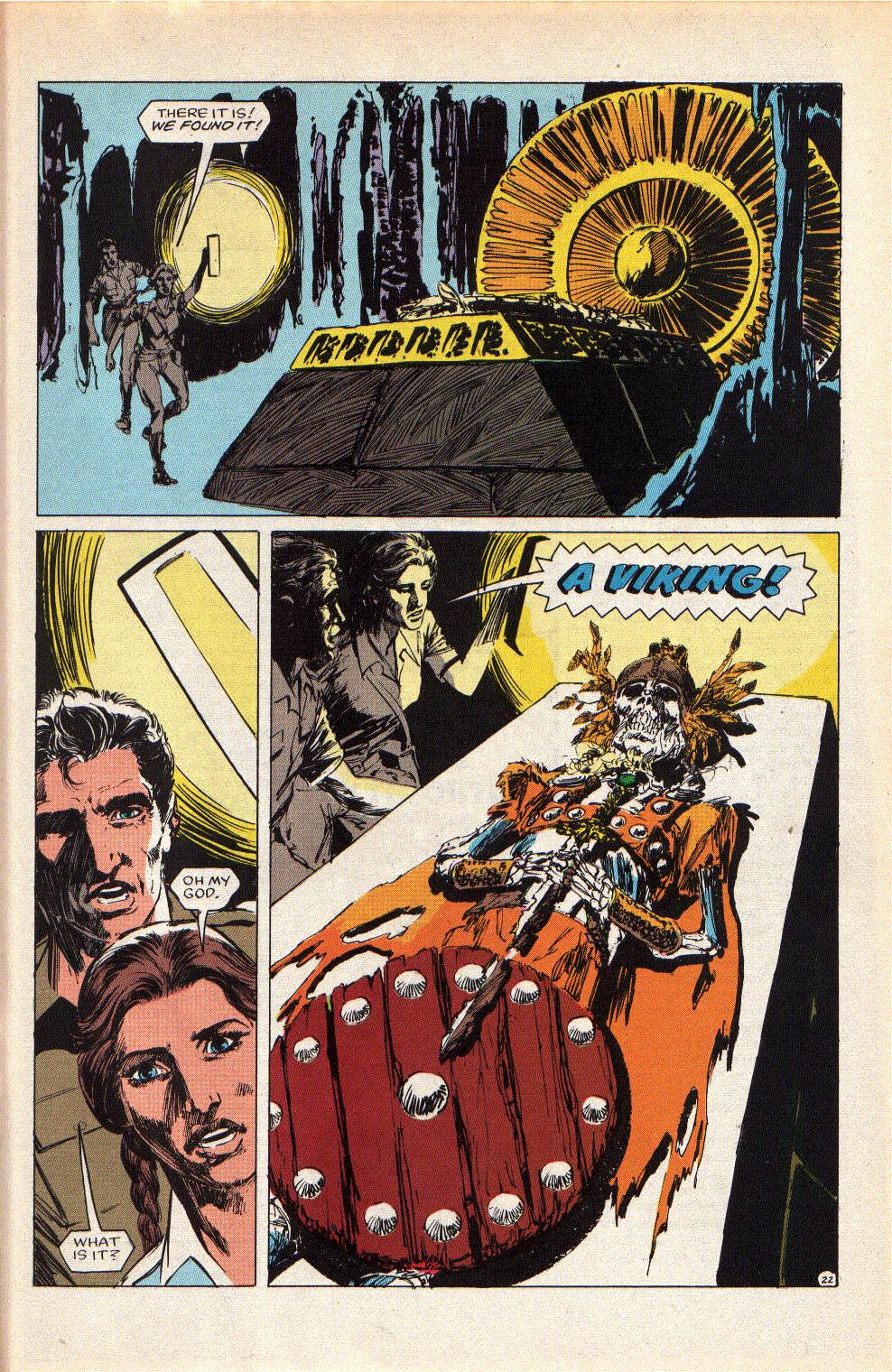 ...though he might have been played by one..... Pretty handy with that axe, for a guy with no depth perception! Jon takes the sword from Wrong Way Olafson, while the Nicaraguan soldiers get a Conquistador up the jaxy! A few more go down to boobytraps, because they can't be as smart as two Americans. One of the locals trips a giant stone hammer, which smashes a wall and lets in the river. Jon and Steph hear to roar as water rushes into the cavern and they make like a Republic serial and run for their lives. The temple is destroyed, but they get ejected out the side....  Jon managed to hang onto Kirk's sword, so they have proof that Prince Valiant came to the Americas.... 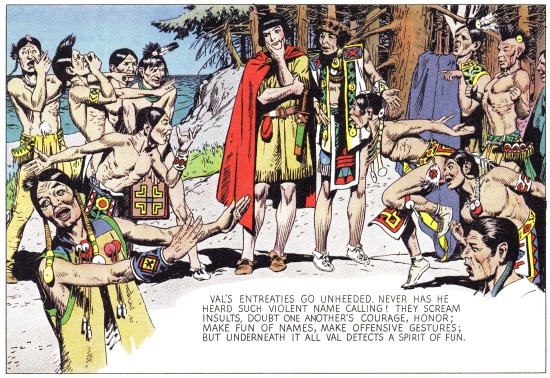 Later, back in New York, at a reception, the sword is on display and Dr Maxwell is the Belle of the Scientific Community. The host pulls Jon away from Steph and introduces him to a guest: Lady Margaret Graemalcyn! Maggie's back in town! Thoughts: Gloriously ridiculous, as Mike steals from every lost treasure epic, including Secret of the Incas (There is a lawyer on the line for you, Mr Lucas....), Raiders of the Lost Ark, Uncle Scrooge (where George and Stephen swiped the boulder gag), and a host of pulp novels, some pseudo-science (why would legends of a white god in the Americas automatically be Jesus, given the world, as he knew it, didn't really extend beyond the Mediterranean and Middle East? Why does "white god" automatically mean Caucasian? Lot of inference and little testing of theories), and some attempts at being John Huston. Actually, Grell did pretty decent banter there, other than at the start. This one is a hoot, a bit more comedy than adventure, but never descending into pure slapstick. Not exactly Romancing the Stone, but a little along those lines, without the romancing part. I also like how Grell connects this issue with the end of the last one, while adding some more character development to Grey, and then sets up Maggie the Cat, for next issue. The boobytrap bit is part of the fun, but is pure pulp and Hollywood nonsense, much like the Curse of King Tut's Tomb, which was manufactured by newspapermen. The engineering for traps like that would have been ridiculously elaborate and would have deteriorated, over time. Still, nothing says archeological adventure like a piercing scream, as someone gets spiked, stepping through a corridor. "No time to argue. Throw me the idol, I throw you the robotic arms!" Grell further references the film, The Vikings, next issue, as we will see a little easter egg, in the exhibit, which is what first clued me into a long-running homage, in Warlord (I hadn't see the film, when I was reading Warlord; I saw it by this point). Next issue will also be some more caper fun, as Maggie has a job, for Jon, to make up for last time. Jon also gets a new toy.
|
|
|
|
Post by codystarbuck on Sept 18, 2021 21:07:17 GMT -5
ps Mike seems to have a thing for women on ladders..... 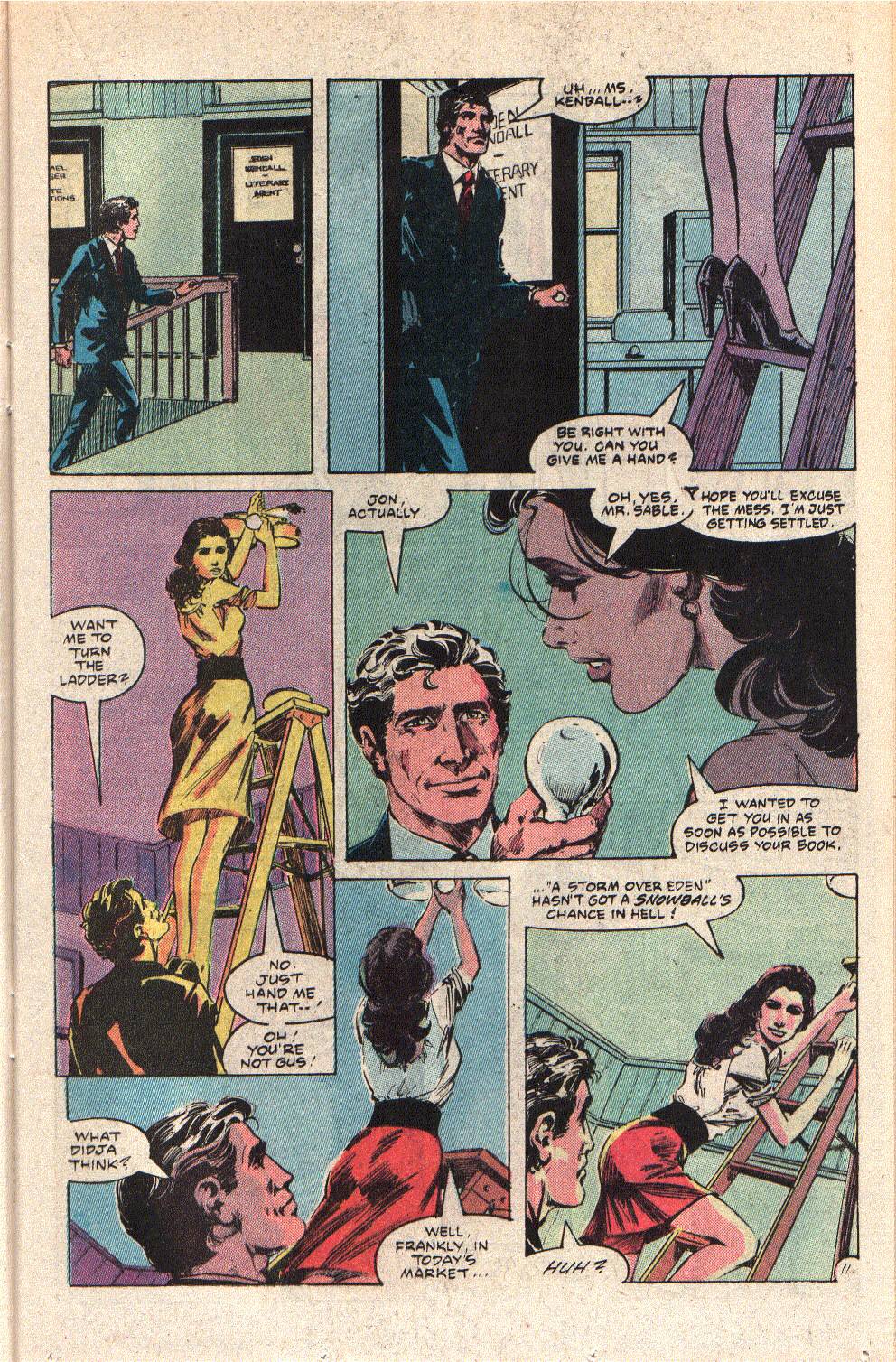  That would be a decidedly specific fetish.... (WARNING! One slightly vulgar term, for a punchline)  |
|
|
|
Post by foxley on Sept 18, 2021 21:58:45 GMT -5
One of these days, I'll have to go back and try to spot all the celebrity cameos in Sable. I'd completely missed the JCVD one. And my father did once tell me "Never argue with a woman with a knife" (regarding interrupting Mum in the kitchen).  |
|
|
|
Post by codystarbuck on Sept 18, 2021 22:15:02 GMT -5
One of these days, I'll have to go back and try to spot all the celebrity cameos in Sable. I'd completely missed the JCVD one. And my father did once tell me "Never argue with a woman with a knife" (regarding interrupting Mum in the kitchen).  I meant in the crowd scenes in that clip from the movie Breakin'. JVD is in the film, as an extra, before Never Retreat, Never Surrender and Bloodsport. He's also got a tiny role in Missing in Action |
|
|
|
Post by foxley on Sept 18, 2021 22:18:40 GMT -5
One of these days, I'll have to go back and try to spot all the celebrity cameos in Sable. I'd completely missed the JCVD one. And my father did once tell me "Never argue with a woman with a knife" (regarding interrupting Mum in the kitchen).  I meant in the crowd scenes in that clip from the movie Breakin'. JVD is in the film, as an extra, before Never Retreat, Never Surrender and Bloodsport. He's also got a tiny role in Missing in Action Whoops!  |
|
|
|
Post by codystarbuck on Sept 22, 2021 22:45:36 GMT -5
Jon Sable #16 As a cat co-habitator (no cat is "owned"), this is one of my favorite covers. Indicia Gag: Repeat of last issue Creative Team: Mike "Bobcat" Grell-story & art, Ken "Abyssinian" Bruzenak-letters, Janice "Tabby" Cohen-colors, Mike "Alley" Gold-editor Speaking of cats, my wife spent who knows how much on some cat tree monstrosity that the older cat turns his nose up at and the younger cat just hops on to occasionally bunch a hanging stuffed bird; and, the kitten has adopted my $15-20 media shelf fixture (now empty, after transferring digital comics to a hard drive) as her own personal set of monkey bars. She is currently hanging on a strut, while trying to haul her butt back up to the shelf. hang in there, kitty! Letters page has nothing but positive comments from people about Maggie the Cat's first appearance, including from TM Maple and Paul Bishop, editor of the Thieftaker Journals, which was a leading newsletter devoted to the mystery genre. Bishop praised Grell for creating a hero who occasionally fails, which adds to the characterization and makes the hero more relatable. Synopsis: We picked up where we left off, with Jon and Maggie reunited, at the museum reception. They banter for a bit, with Maggie saying she was not there to steal the viking sword that Jon and Steph had brought back from Nicaragua. The night goes on and ends and Jon comes home, to find out he needs to get a better security system.... 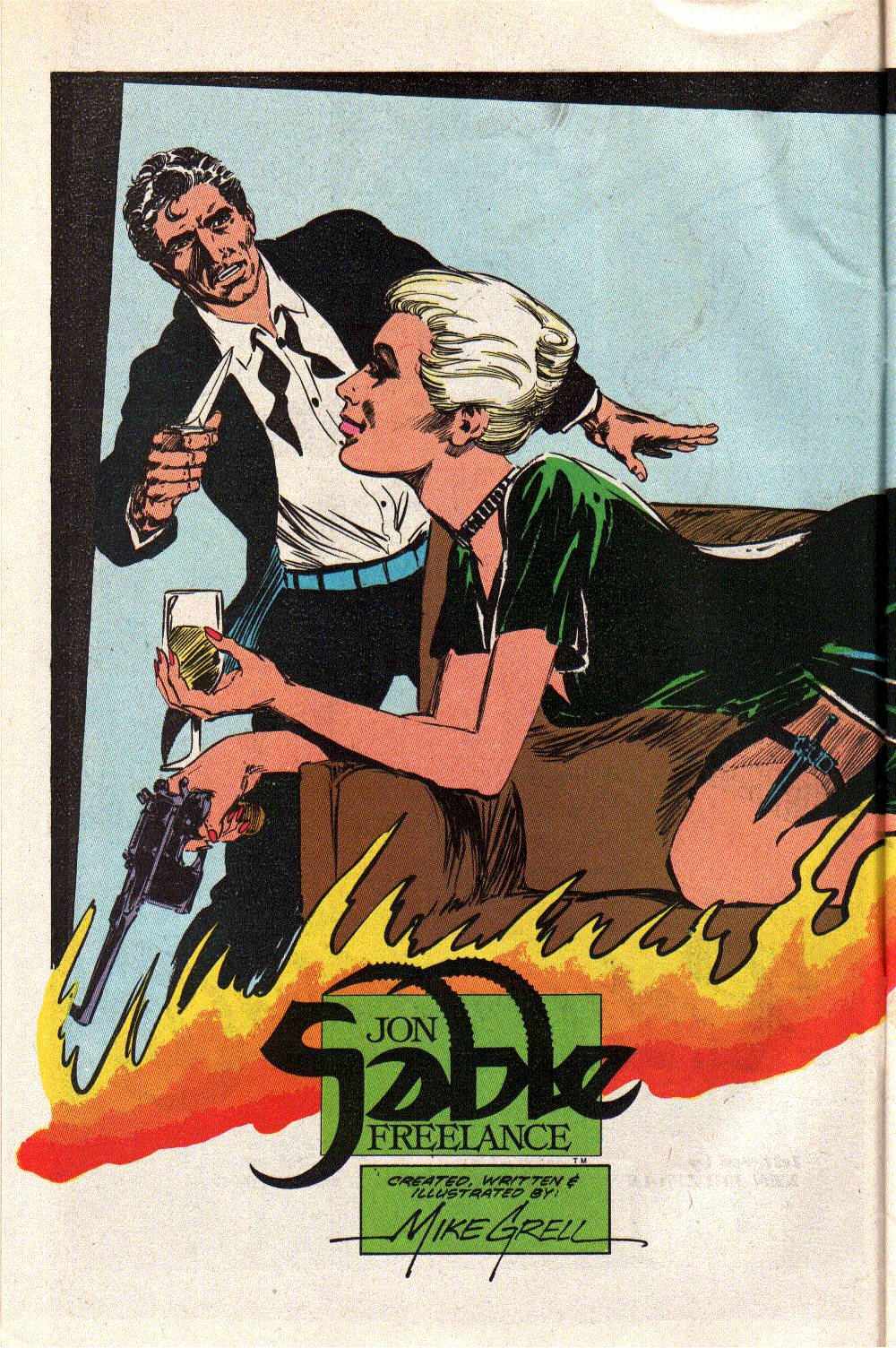  Maggie plays around, asking Jon about his Mauser (where Grell explains it is a hybrid of a .45 cal Chinese barrel and a schnellfeuer automatic feed mechanism, to give him a selective fire .45 cal pistol, with a longer, more accurate barrel. Jon then takes it from her hands and demands to know why she is there. She says she needs his help and asks if he knows what 7X is. He jokes that it is a Stetson hat size and she explains it is an industrial formula that was closely guarded and has been stolen, from a vault in Atlanta. She is out to catch the thieves, who did a Dirty Mary and Crazy Larry and kidnapped a bank presidents wife and children and forced him to open the vault. She broke into the company offices and stole their dossier on the thieves... 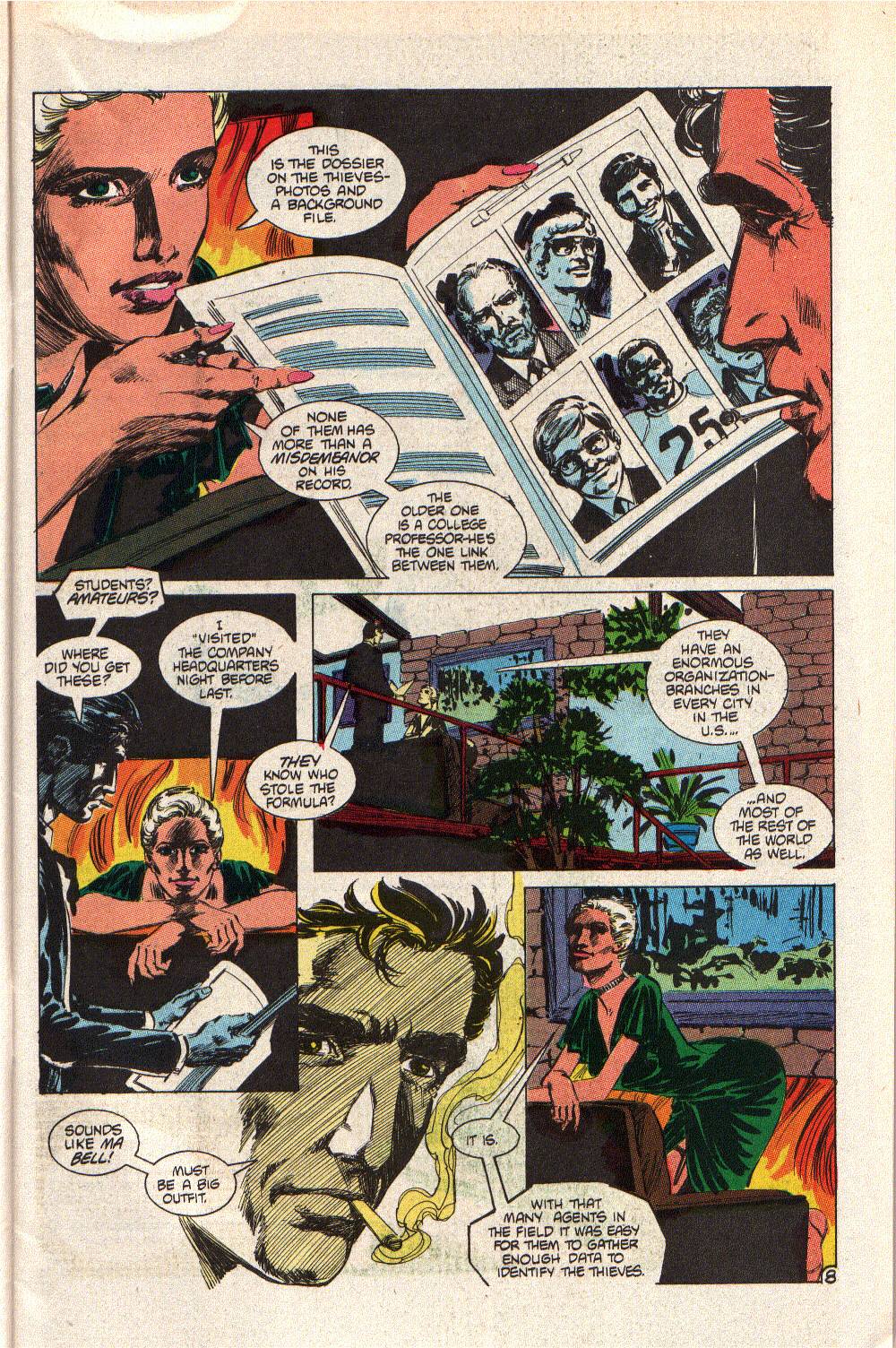 Maggie doesn't intend to return the formula, though (of course); the thieves are looking to auction it off and have spread the word. Maggie intends to steal it and sell it to the highest bidder. The company is a big deal, offices in every major city and around the globe, including their own corporate security; but, they are letting the authorities deal with it. The thieves have been traced to a fortress, in the Bahamas, built by a Prohibition-era bootlegger, and have an arsenal of small arms to defend it. Jon looks over the intel and says that they have the firepower to defend the place. The kicker is that the company offered a quarter of a million dollars to return the formula, unopened, with no prosecution. The other potential buyers have stipulated they want the formula unopened. The thieves have threatened to broadcast the formula to the world, allowing it to be duplicated and the company would lose a billion dollars. Maggie intends to get there first and take it and needs Jon's help to pull it off, quietly. She offers Jon the potential for $5 million (from a Japanese bidder), the danger and then some personal enticement. Maggie wakes up the next day, wearing nothing but her favorite choker (with the Capitolio jewel replacing the previous ruby). She puts on Jon's shirt and pokes around the house. She eventually goes down to Hogan's Alley and finds Jon compensating for something..... 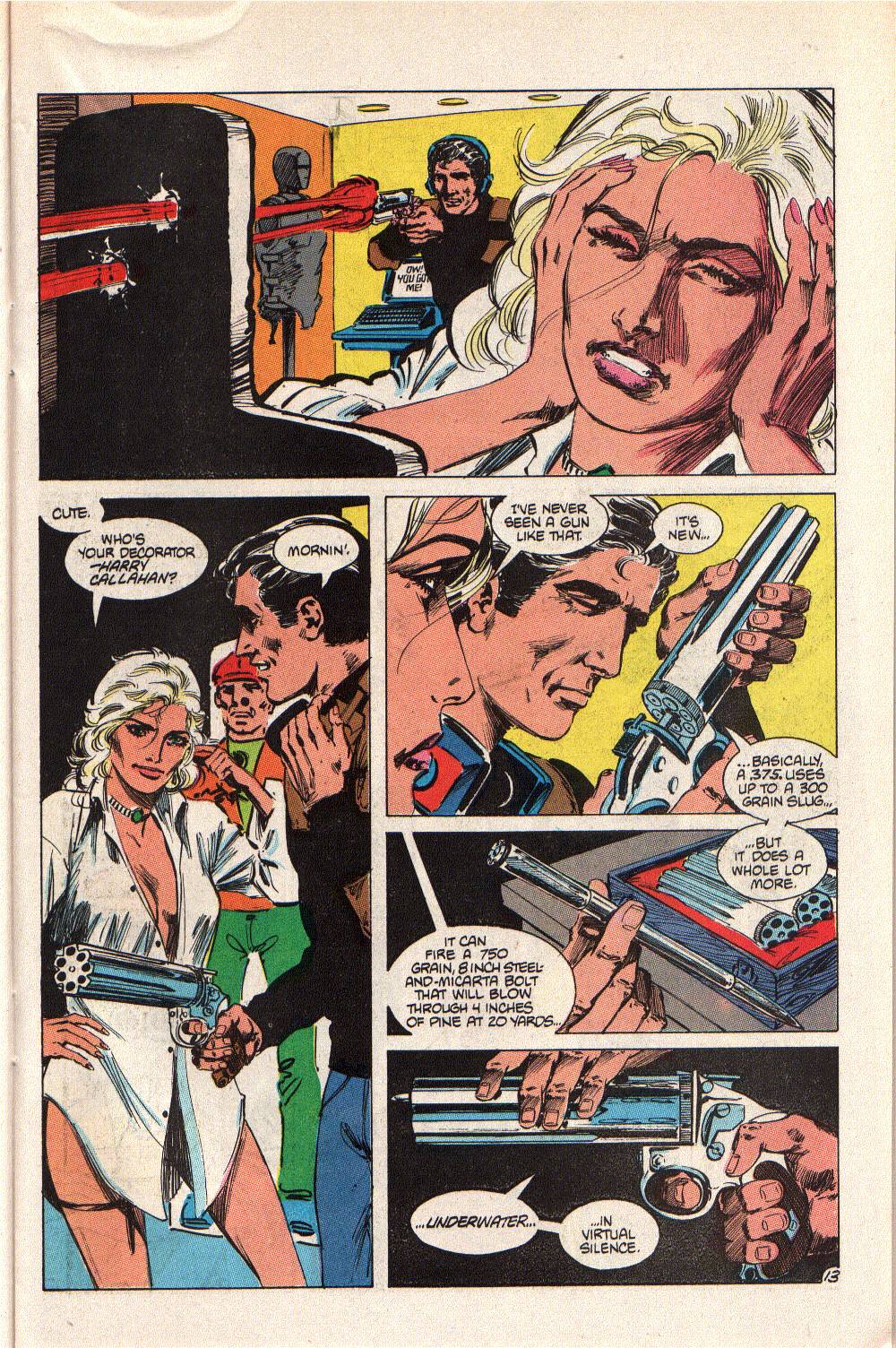 Jon is firing a pepperbox style pistol.....  with one hell of a bang and kick. he explains that it is new, a .375 cal weapon, which can also fire an 8 inch steel-and-micarta bolt, through 4 inches of pine, underwater. It can also fire a line over long distances, fire tear gas cartridges, fragmentation rounds, or high explosive rounds. The cylinder contains the barrel and rifling and can be removed and another inserted, making one person an army, with a selection of specially loaded cylinders. it will also shoot through a kevlar ballistic vest. Maggie gives it a try and is impressed. Jon is in. The pair recon the fortress, in the Bahamas, while Maggie still keeps the name of the company quiet. After a thorough recon, they do a scuba insertion, using swimmer torpedoes to cover the distance. They pop up out of the water and neutralize a sentry. They move in, while the criminology professor and his students jaw about his contacts and brilliance.... 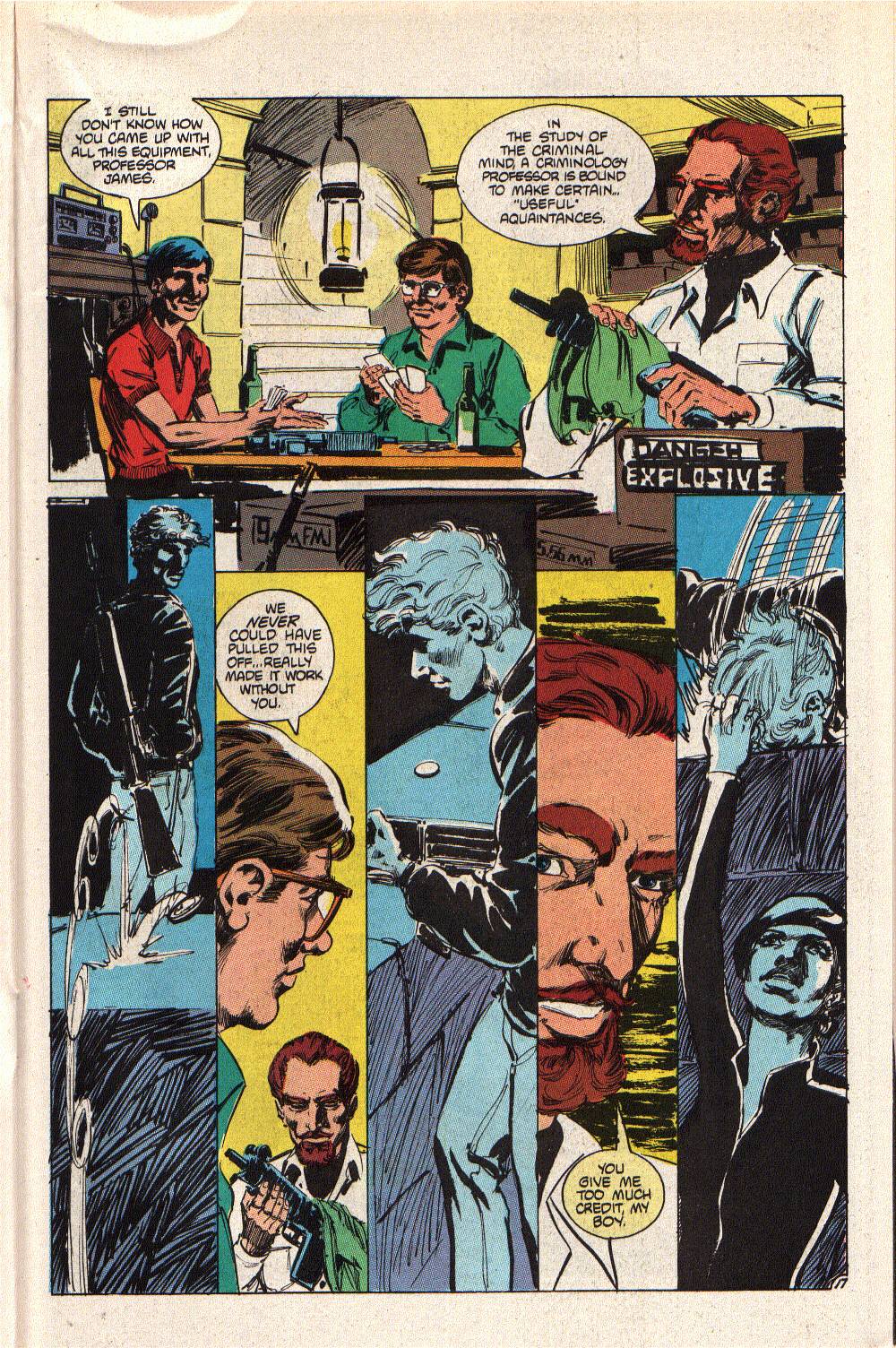 Academia will never trump field experience! Jon and Maggie scale the outside of the building, while we learn that the whole thing started as an exercise to plan the perfect crime and the students actually accomplished it, though the prof added the money touches that made it more lucrative. Maggie hits the safe, while the idiot student who was supposed to be guarding the office goes for a couple of beers. The prof tells him to get back and the guy runs into Maggie cracking the safe. he opens fire with his MAC 10 Ingram and Maggie dives over a desk and kicks him in the gut and knocks him through the window. Sable opens fire with his handcannon, to distract the defenders to a different part of the building, while he swings through the broken window to give Maggie backup. He gives the defenders a reason to keep their heads down, while Maggie finishes her job. Maggie opens the safe, but it is empty. The students learn that the prof was planning to doublecross them. he shoots one, then tosses a Coleman lantern onto a box marked "explosives." he makes his escape, while Jon and Maggie make theirs. The prof goes for a boat and the heroes hit the water. he opens fire at them and they dive. Jon uses the handcannon to to illustrate "Chekov's Gun." 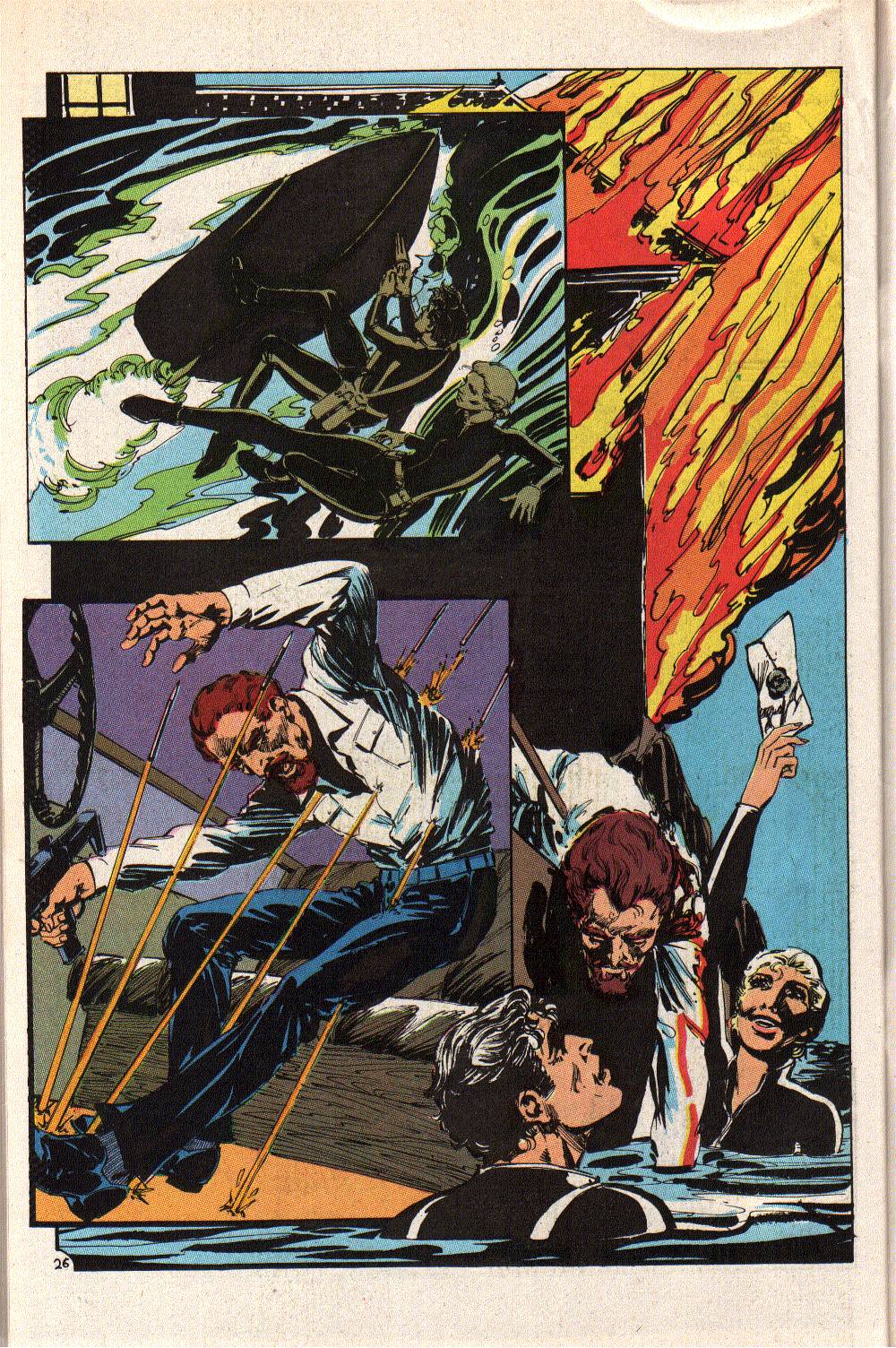 Maggie recovers the sealed formula from the water. We next see them in Atlanta, as Jon has forced Maggie to return it, knowing that they will be targeted by the company, if they sell it. He is shocked to see who the company is, when they enter their corporate headquarters. They are claiming the quarter mil previously offered the thieves and Jon hands over the formula and then tells the corporate weasel that you can get that in any store. The man explains the mystique of the whole thing is worth more than the actual formula. 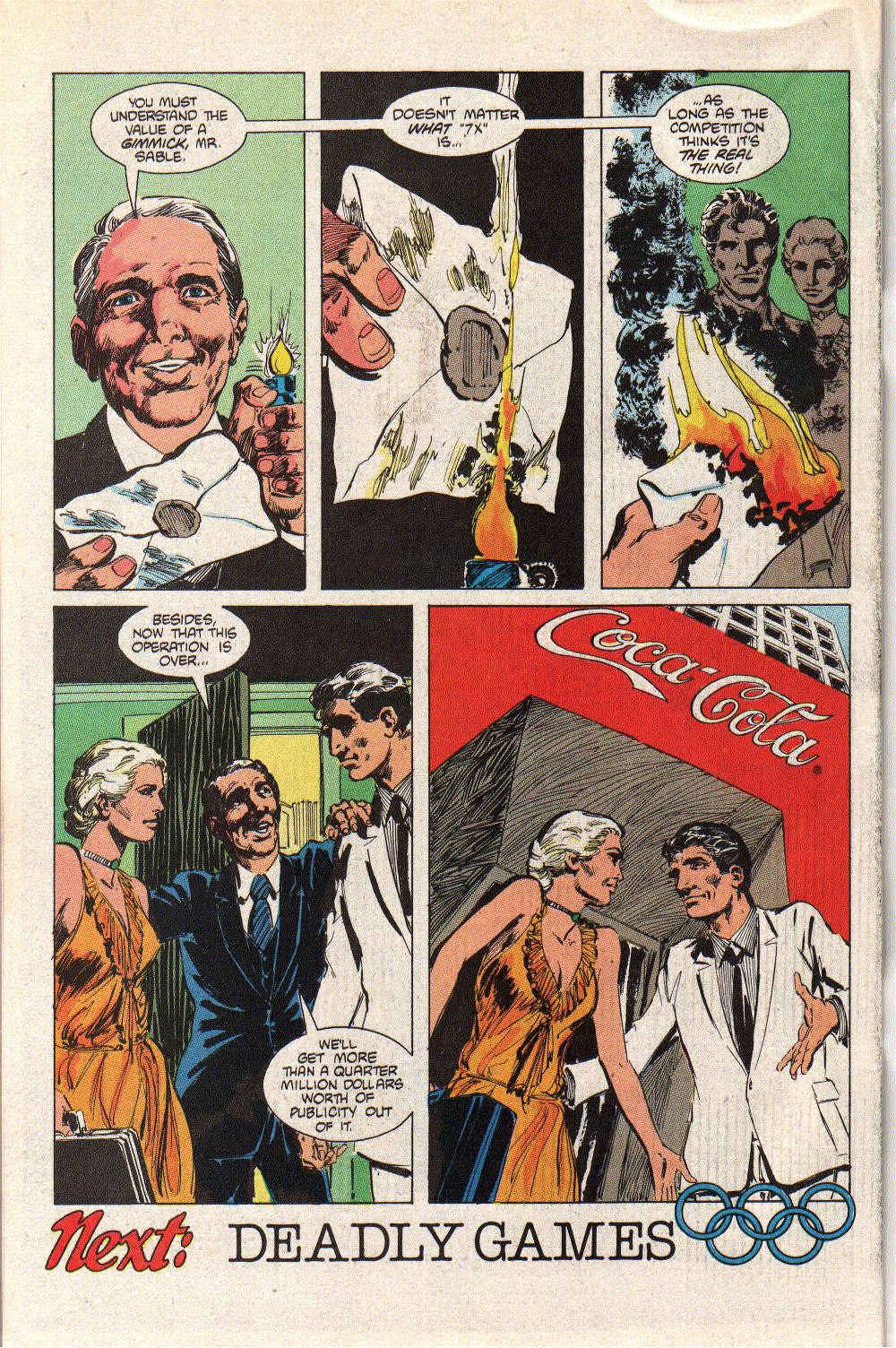 Thoughts: Thoughts: Jon and Maggie steal back the secret formula for Coca-Cola! Now, that's a plot! Once again, Jon proves what a great character Maggie is, as she brings trouble into his life again, though they are on the same side, this time. Maggie's capers are pure fun (as any well plotted caper should be) and it allows for a lighter Jon to operate, though there is still an element of danger. Now, the criminology professor and class is a bit of a stretch, but there are real world precedents. A group of MIT students hit casinos between 1979 and the early 2000s to beat the odds with mathematics. The professor character is reminiscent of one played by Edward G Robinson, in the film Seven Thieves. in that film, a discredited professor gets a former protege and a crew together to rob a casino, in Monte Carlo. The main difference is that this one is more active and not trustworthy. The professor says the flaw in the plan was the students trusting him. The flaw is in amateurs thinking that planning alone brings success. Training and experience is what makes a plan a success. The students have no idea about the weapons they are carrying, have never done anything dangerous in their lives (most likely) and certainly haven't been in high pressure situations that test their nerves and ability to carry out the plan in the face of adversity, not to mention improvise when something doesn't come off, as planned. meanwhile, Maggie is an experienced thief, whose business requires steal nerves, planning and the ability to improvise. Jon is an experienced combat soldier, marksman and survivor. They are a formidable team. They also have experience with working with others, while the students aren't used to doing that, in this kind of environment. They most likely would have had little or no experience with small arms, particularly selective fire weapons. Those weapons need to be maintained, to operate properly and there is a big difference between firing a pistol, on a target range, and a submachine gun. Automatic fire tends to push the weapon into a certain direction, in response to the expended rounds (just ask Isaac Newton). It takes training to learn to keep the weapon on target. Once the s@#$ starts flying, they prove they don't know what they are doing. Maggie and Jon make quick work of them, while the professor takes care of the rest. The Coca-Cola reveal is set up beautifully. Coke did make a big deal about a secret recipe, for years, before the whole New Coke debacle (though the demand for the original gave them tons of free publicity). They are headquartered in Atlanta, with bottling company offices all over. If you paid attention, you might have an inkling of who this was (assuming you were up on major corporations, with worldwide offices). It is conceivable that someone might try to steal the formula to sell it off. Stranger things have happened. Realistically, the actual formula is worthless, as they don't use the same ingredients that they once did. Regardless, reverse engineering got other colas to taste close enough to fool people (I always preferred RC Cola, when I drank the sugared stuff. Pepsi's formula was different, because it had a sweeter taste, which is part of why Coke went with New Coke, which mirrored it, as younger generations were being conditioned to high sugar and sweetener levels in processed foods, thanks to the introduction of high fructose corn syrup (thank you Archer Daniels Midland, from my old stomping ground). As the exec says, it was the mystique of the formula that gave it power, not the actual thing (same with Col Sanders secret KFC recipe). We are teased with clues and Jon's reaction when they arrive at the headquarters, then grell gives us the punchline, as they leave, with the logo. Now, Jon's pistol deserves some discussion. Ever since I first read this story, I have looked for any reference to this weapon I could find and have come up with bupkis. Pepeprbox pistols have been around since the muzzleloader days (the Knock Volley gun is a forerunner) and several styles were manufactured in the 1800s. Nothing like this, though. .375 is a rifle cartridge, what Jon's hunting rifle was chambered for. that's a ton of kinetic energy in a small package. The recoil would be hellacious. In conception, it bears a closer resemblance to a Lancaster pistol, aka a Howdah pistol. These were two or 4-barrel pistols (really, a short carbine) chambered for a variety of rounds, including some large bore calibers. They were favored by big game hunters for close range with a charging animal (as seen in Ghost in the Darkness).  The closest I can come to something Sable describes, in terms of the specialized cartridges, is the Heckler and Koch P-11...  That weapon was developed in the late 70s and consisted of 5 barrels, that fired steel darts, electrically, from a battery pack. Once all 5 were fired, it had to be reloaded, at the manufacturer. It was designed for use by SEALs and similar combat swimmer teams. I forgot to ask Grell about it, when I met him, as we got caught up in too many other things. I assume, based on other tech in the series, that he came across it in some kind of gun magazine or Popular Mechanics/Popular Science type magazine. It's possible that some outfit was doing some kind of custom job like that, though, usually, they would try to publicize that and there would be some kind of record. That's why I think it was either a prototype that didn't sell or Grell took the idea of something like the P-11 and matched it to the pepperbox (his drawing does have some resemblance to a few pepperbox designs), and gave it more modern stylings. Grell used the weapon sparingly, in the series, but it makes further appearances. Sadly, other than the transition next issue, Maggie does not. Well, in this series, but she does return for her two issue Image series, which was killed with a storyline still in progress. I plan to cover it, just 'cause. This issue is a great example of Grell's attention to detail, both in the narrative and the art. Mike gives us plenty of views of the handcannon, to get us used to the idea of it, before he pulls it out in action sequences. When Jon and Maggie are talking, by the fire, in his place, Grell sets the atmosphere (aided by Janice Cohen's coloring), with bodylanguage and lighting, but he also adds touches that many artist skip. Sable's tie is hanging loose and his shirt is open. We see the folds in the sleeves of his jacket, created by his posture. Maggie's dress has folds in the sleeves and hemline. Grell even draws little lies around the toes to indicate that Maggie is wearing hosiery. They look like a couple that is getting comfortable, after a big evening event and all of these little touches sell it better than the fire itself does. Grell uses cinematic staging in his panels, which adds to the feeling that these are movies on paper or novels with an illustrated story, which is what comics do best. Grell finds that happy middleground that so few creators really do, using the unique elements of the comic book medium to tell stories only they can. Grell eschews thought balloons, mainly because he can sell what a character is thinking by bodylanguage. Once in a while, his layout is a little hard to follow (the first time, at least, until you reread the sequence), but, he is a storyteller and he knows his medium. Why Hollywood couldn't get it, I don't know, other than typical arrogance (What does a comic book artist know about telling stories?)
|
|
|
|
Post by foxley on Sept 23, 2021 0:34:32 GMT -5
This very well might be my favourite issue of Sable.
According to an interview with Grell I read, he said that the Magnum pepperbox was an actual gun that he came across in a gun magazine (unfortunately he didn't mention which one). Apparently it was a prototype weapon built in response to a contract to develop a multipurpose sidearm for Navy SEAL operations. Grell was under the impression that the gun was going into production (and hence Sable would be able to get his hands on one), but ultimately it did not win the contract (or maybe the contract did not go ahead) and the prototype was the only one ever produced.
|
|
|
|
Post by foxley on Sept 23, 2021 5:43:53 GMT -5
After a bit of research, I'm now wondering if what Mike saw was some sort of planned variant of the Mk. 1 Underwater Defense Gun: the US Navy's predecessor to the H&K P11. It was introduced in the early 1970s, but was never popular and phased out in 1976 in favour of the P11. It hits most of the features of Sable's gun. It is a double action only pepper-box weapon, and its removable cylinder magazine fits into the side of a gun, being inserted and removed through a door on the left side of the gun. It fires the Mark 59, a stainless steel cylinder containing a single 4.25 inch long heavy tungsten dart. The self-contained design of the Mark 59 contributes to the propellant gases being kept in the cartridge, which eliminates muzzle blast that could produce a dangerous shock wave. It also has the side effect of eliminating muzzle flash and reducing sound. Here are a couple of photos showing the design is not a million miles away from what Mike draws. Unfortunately, I couldn't find a photo shown the gun muzzle to see the full pepper box configuration.   |
|
















